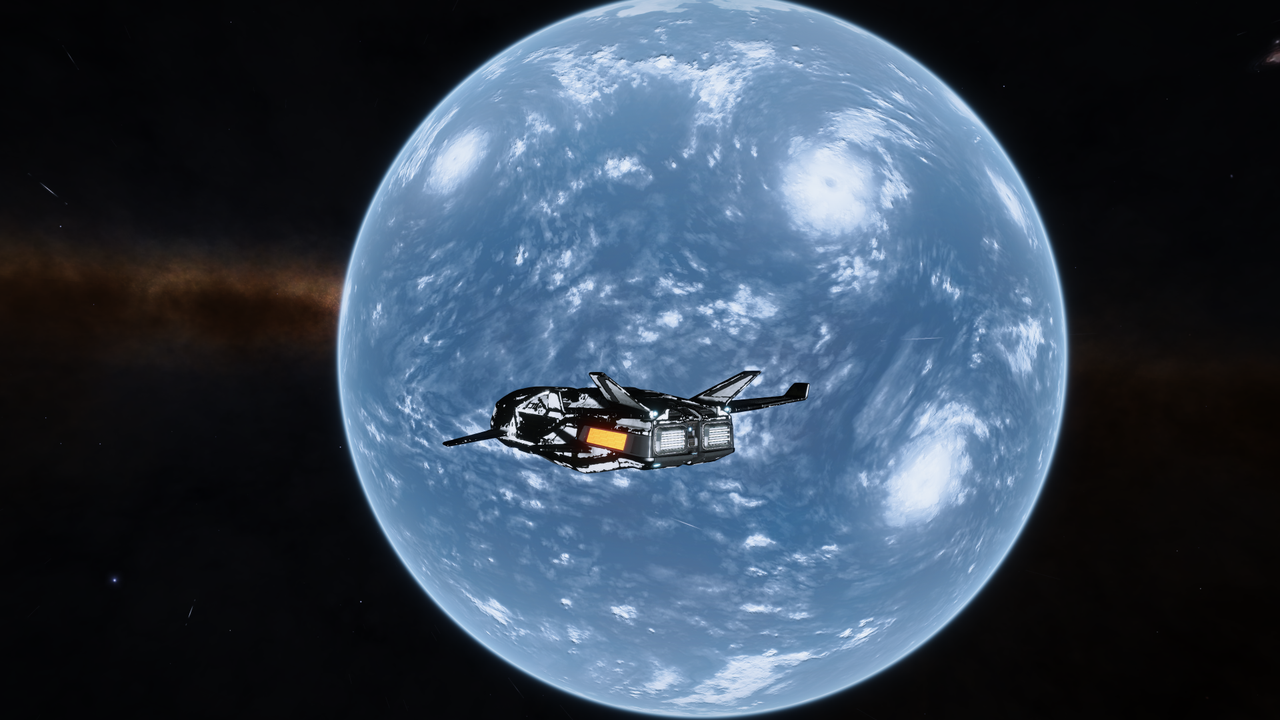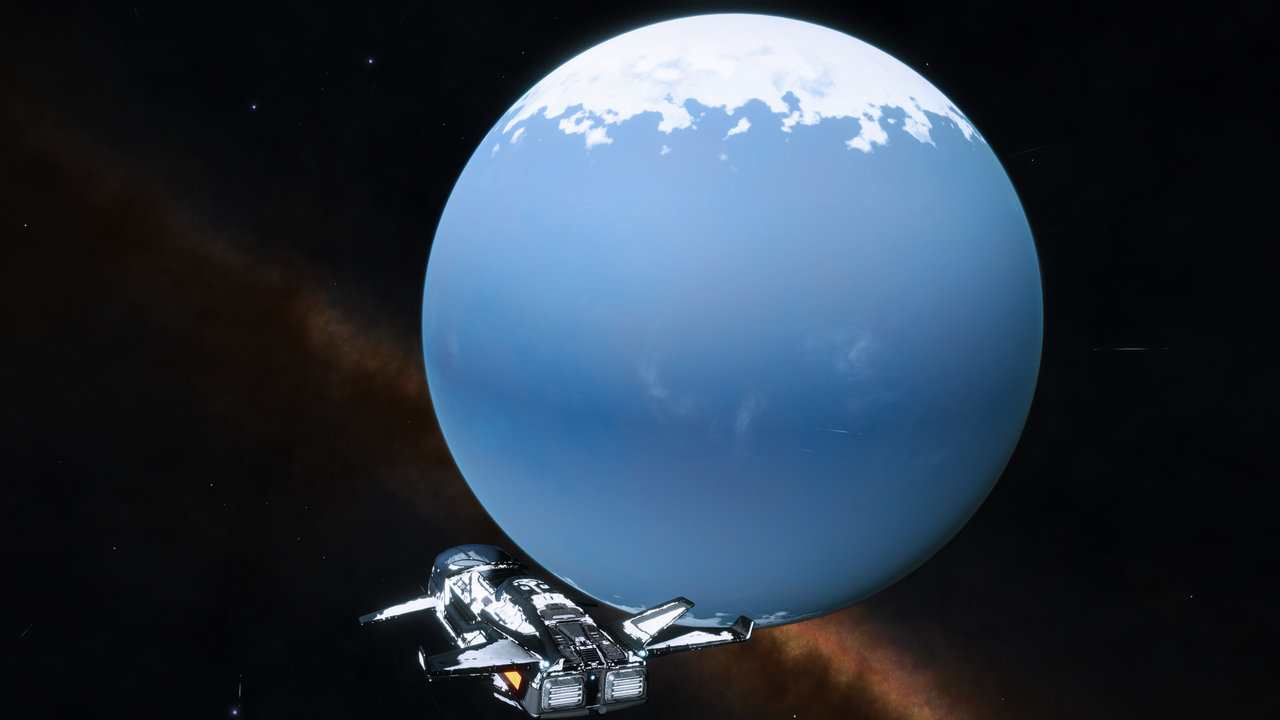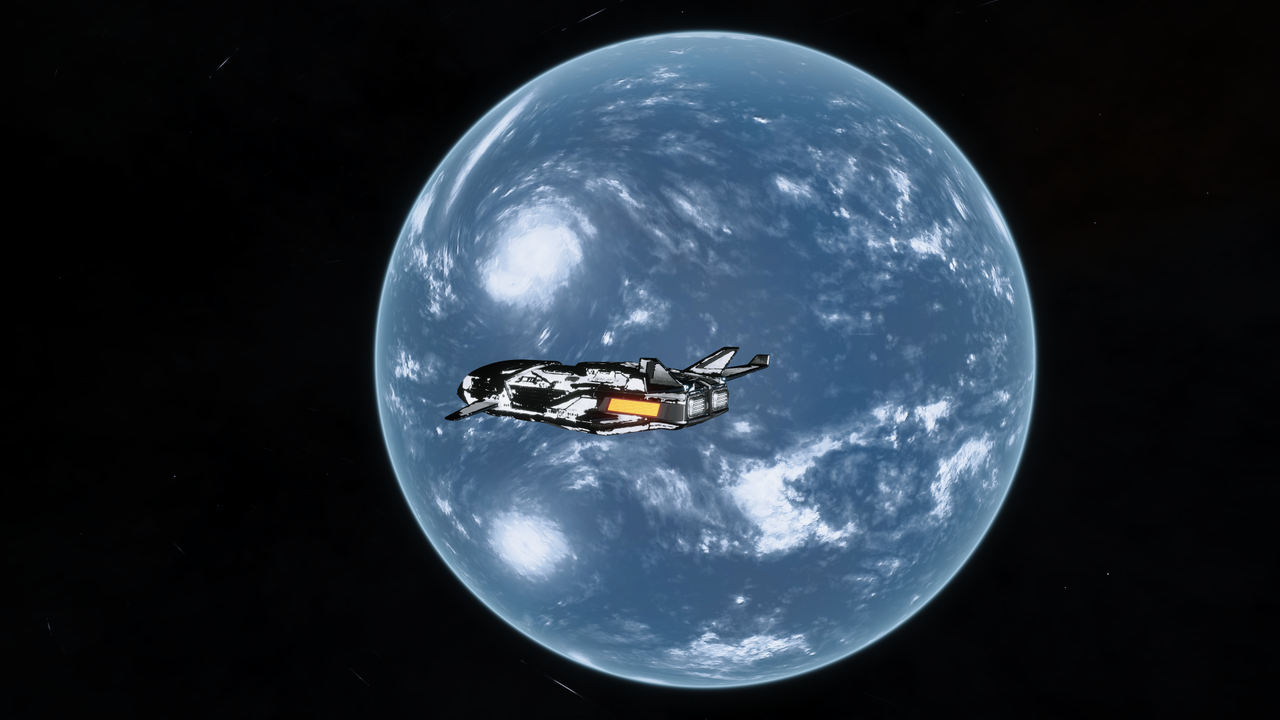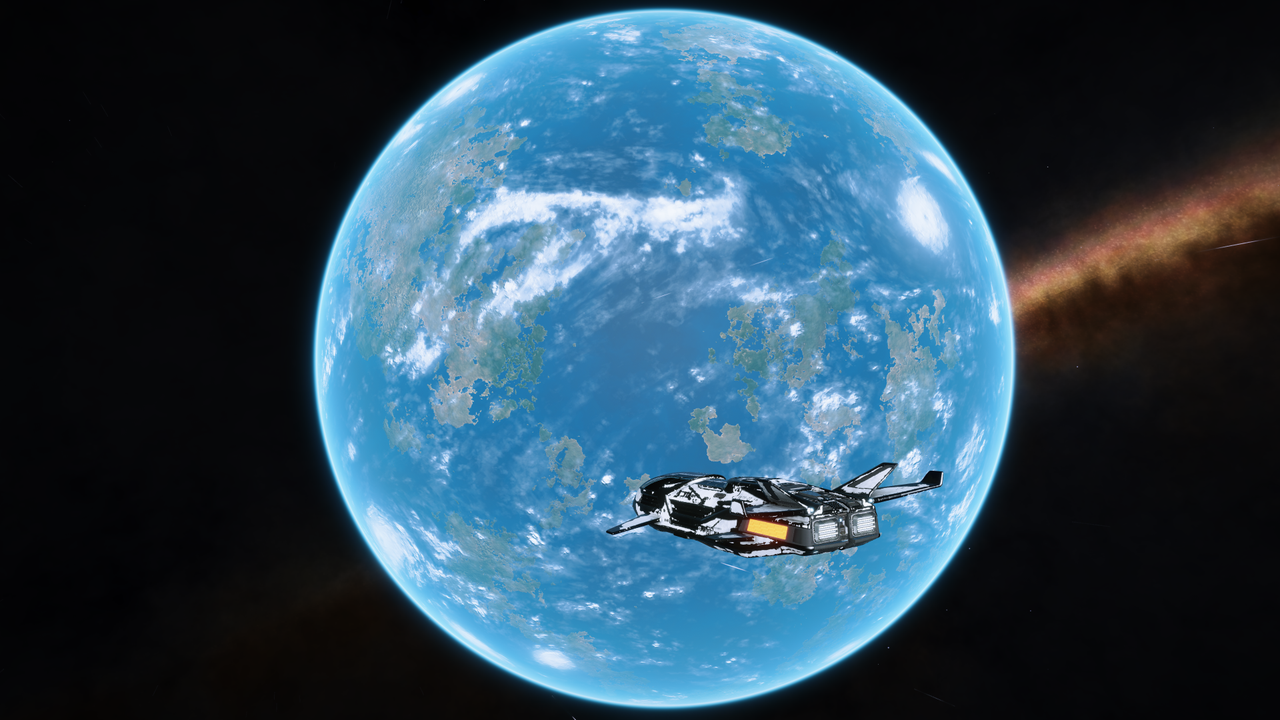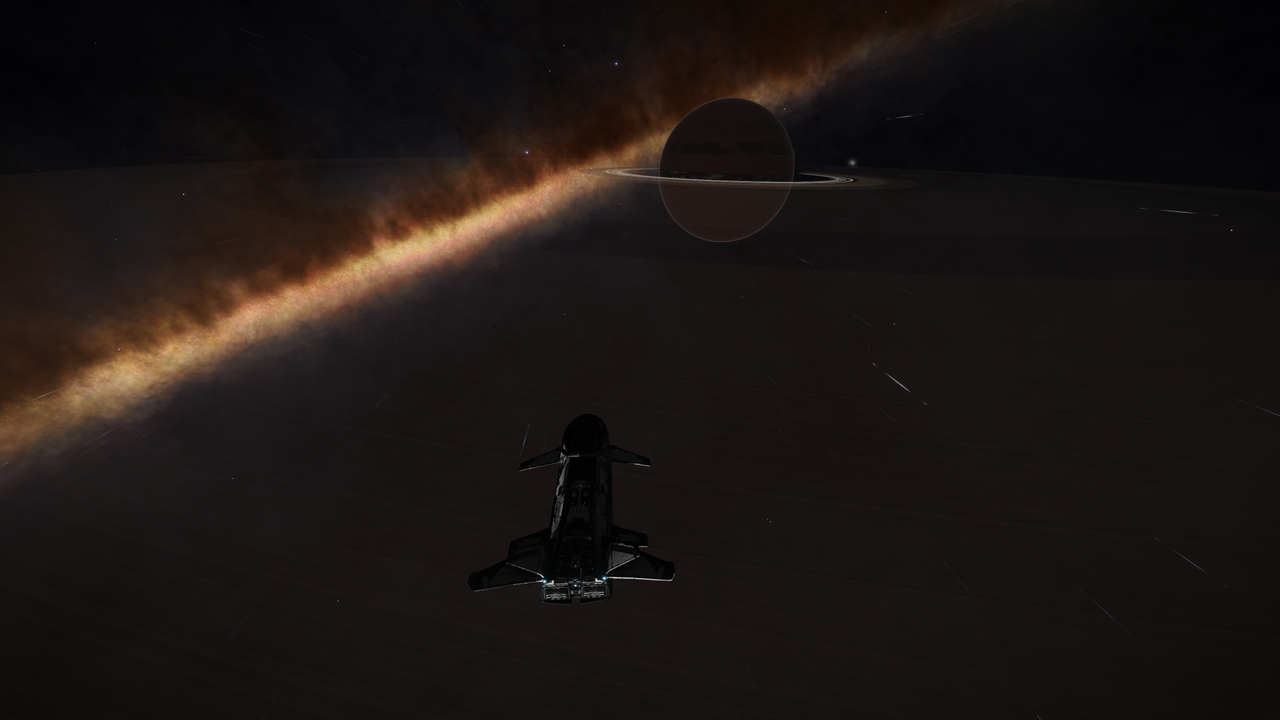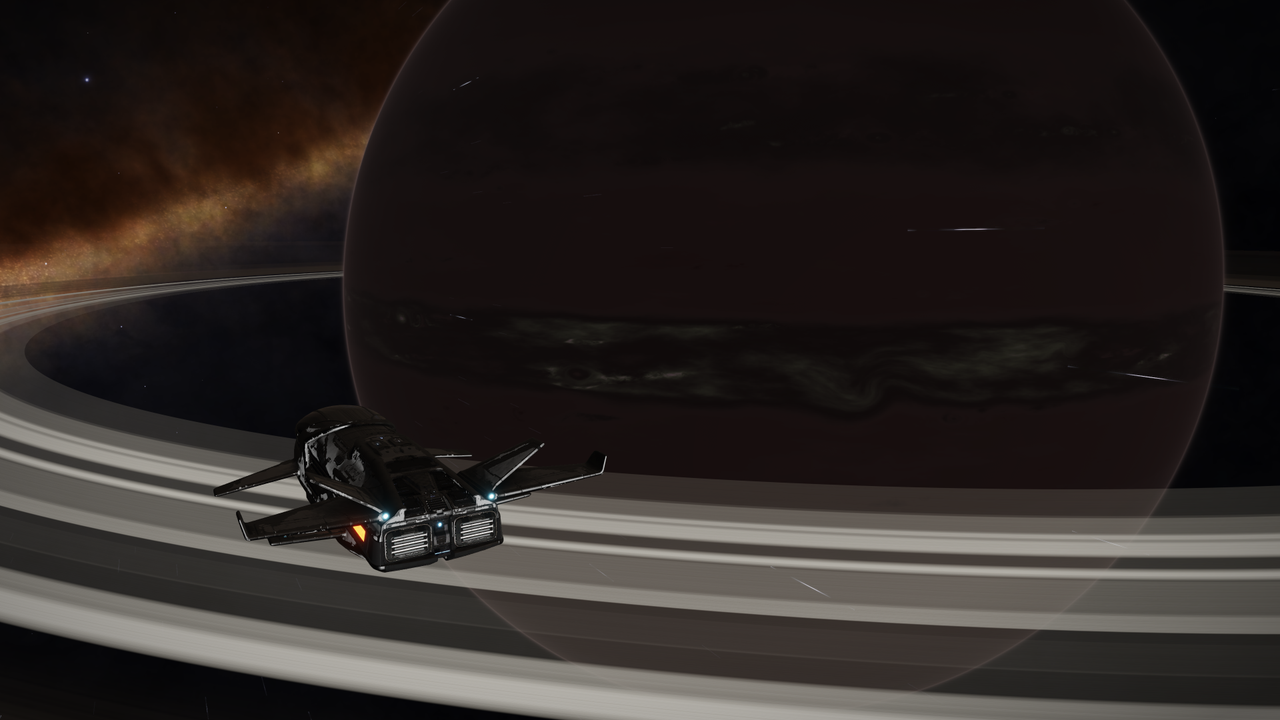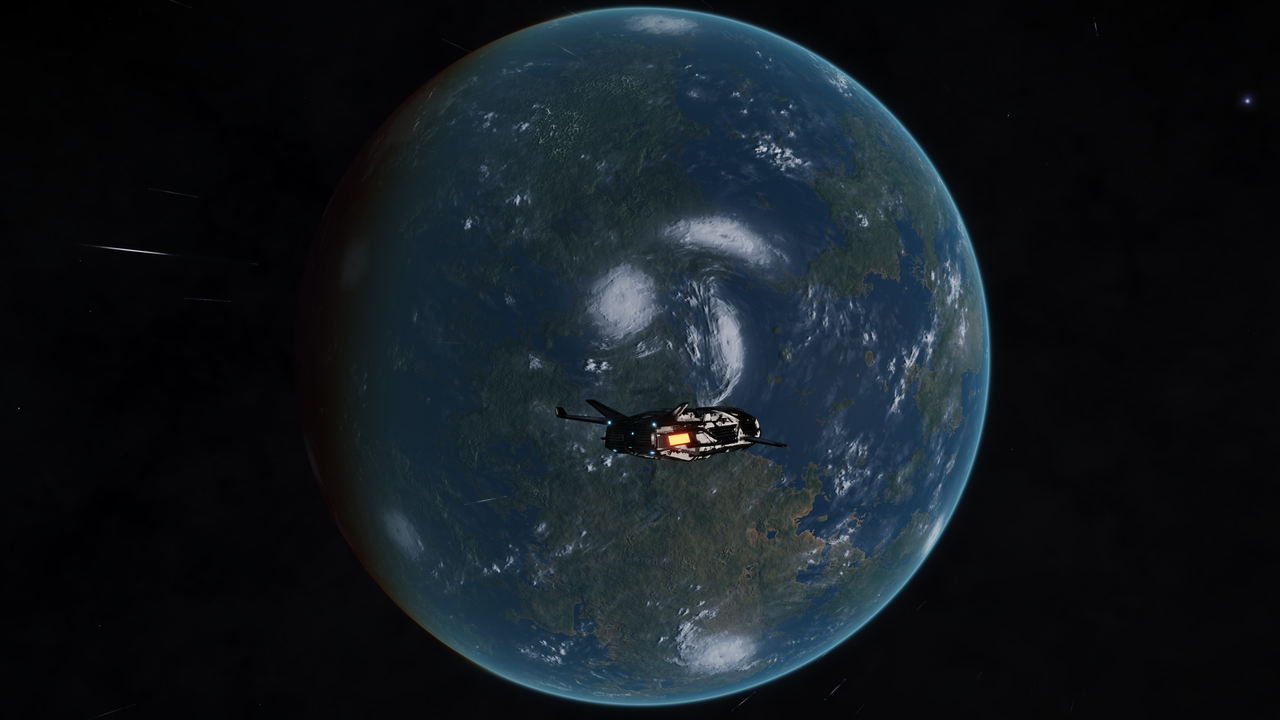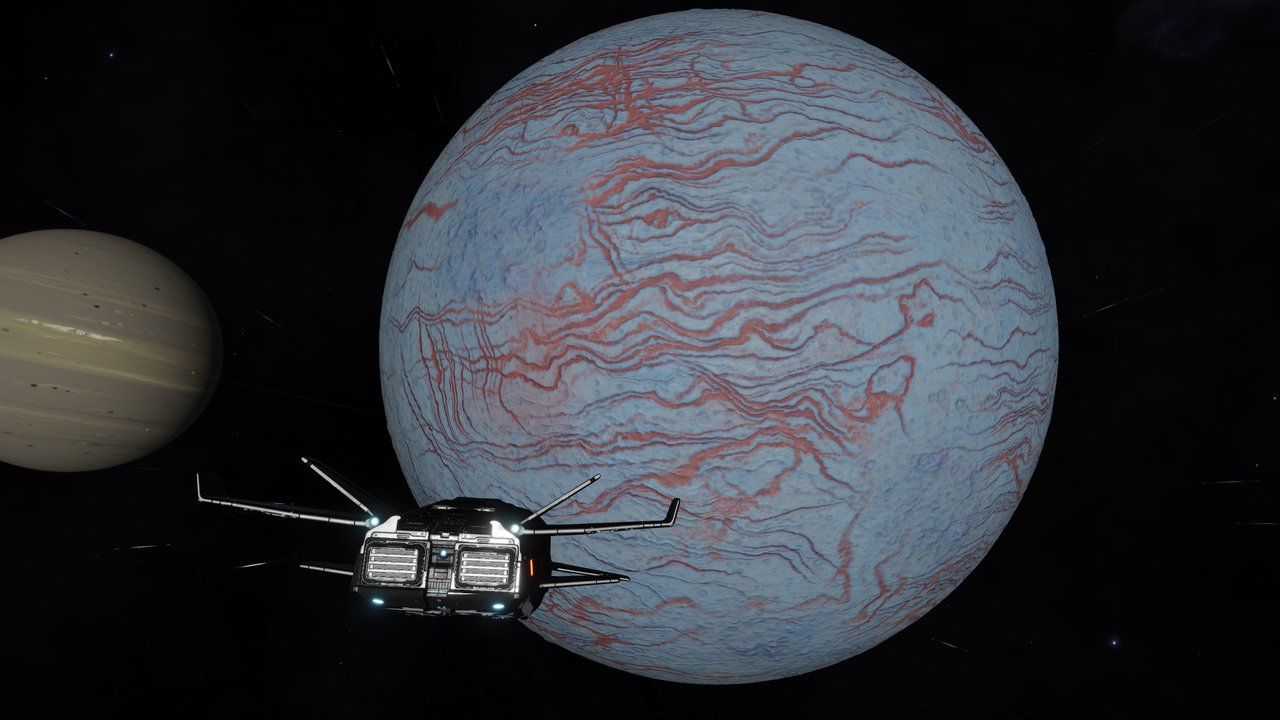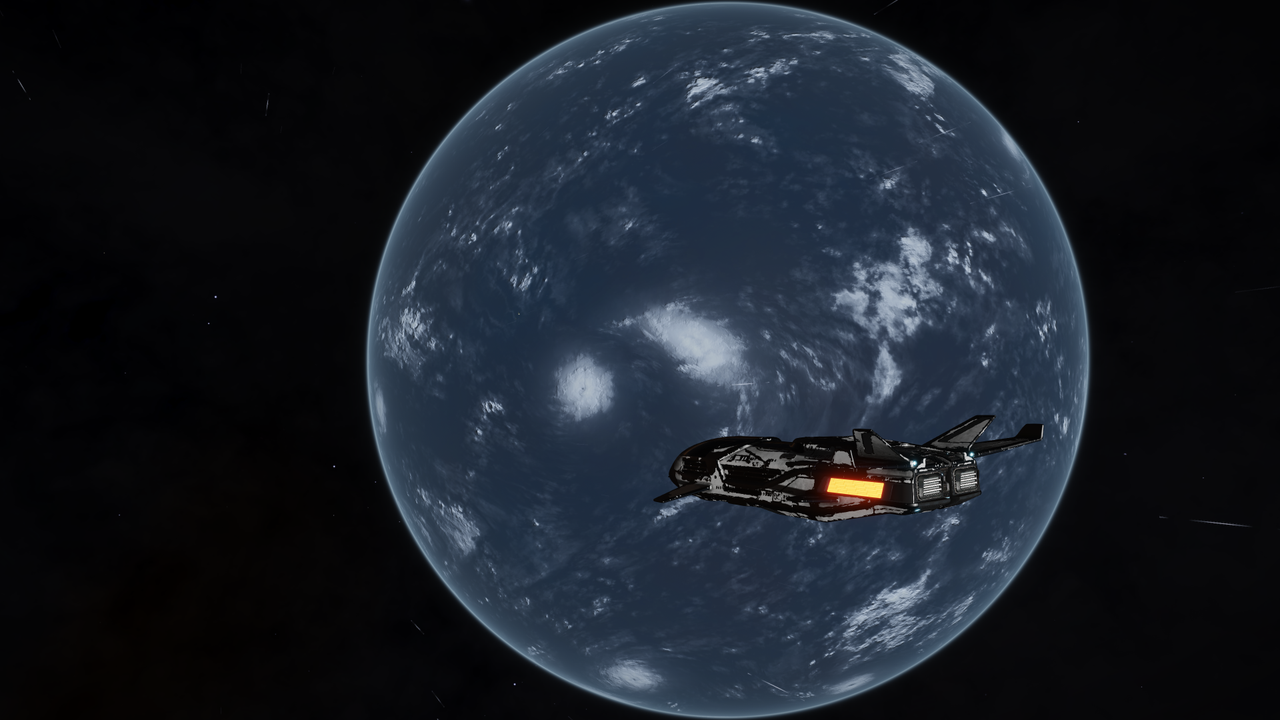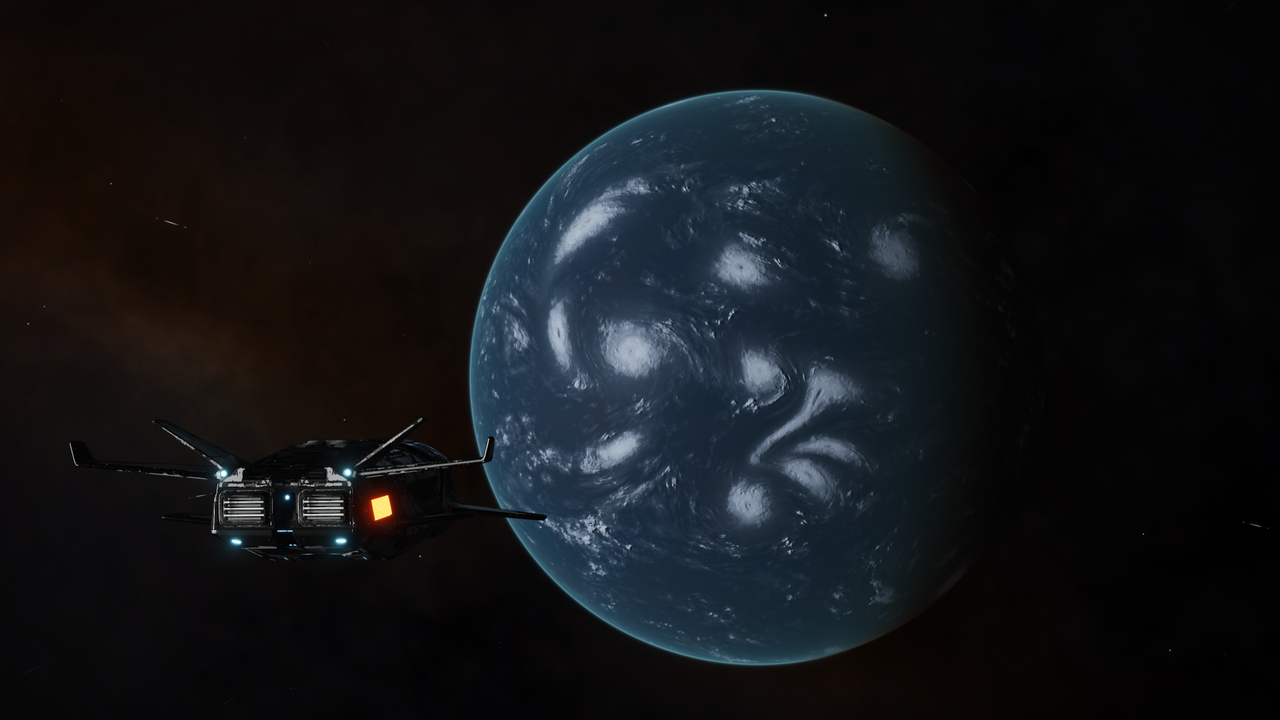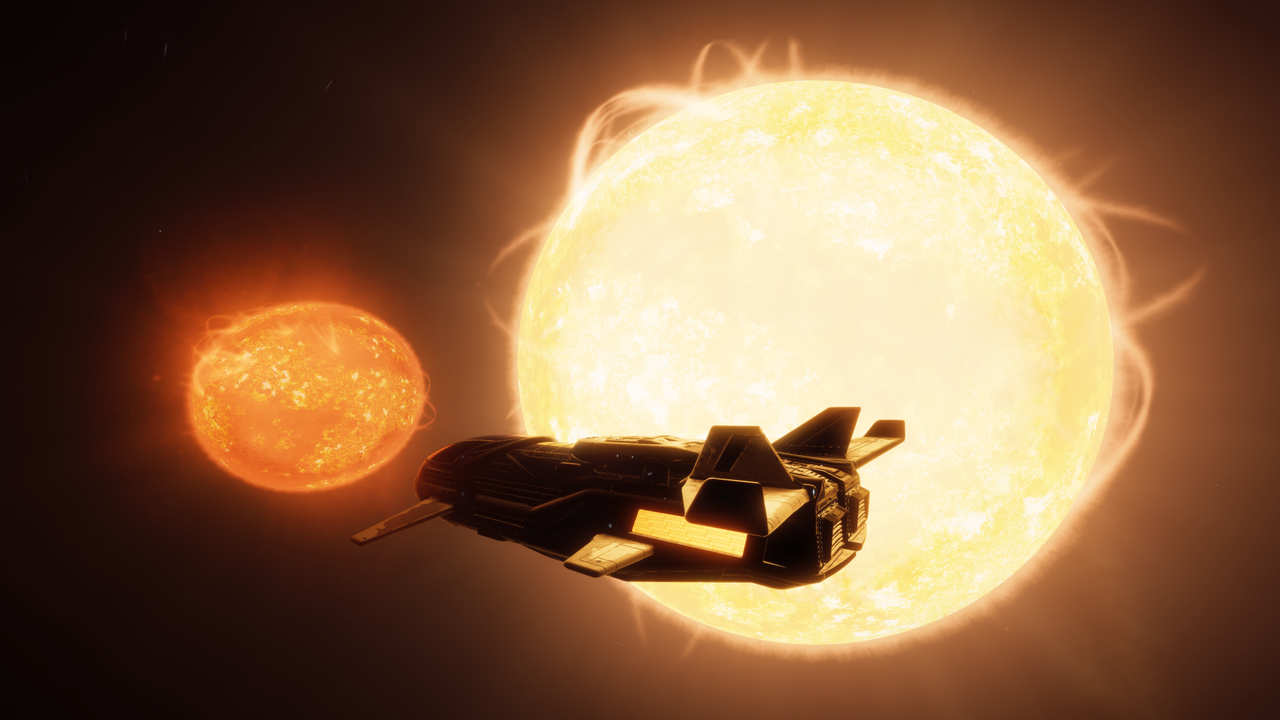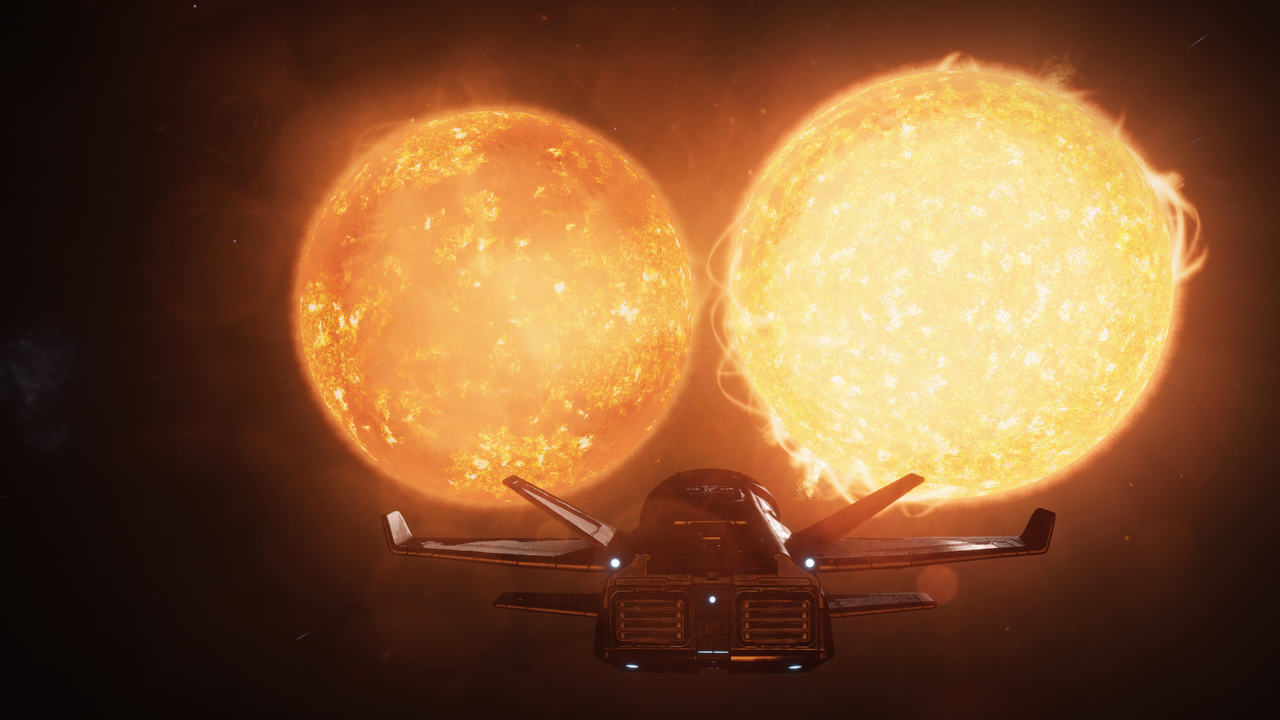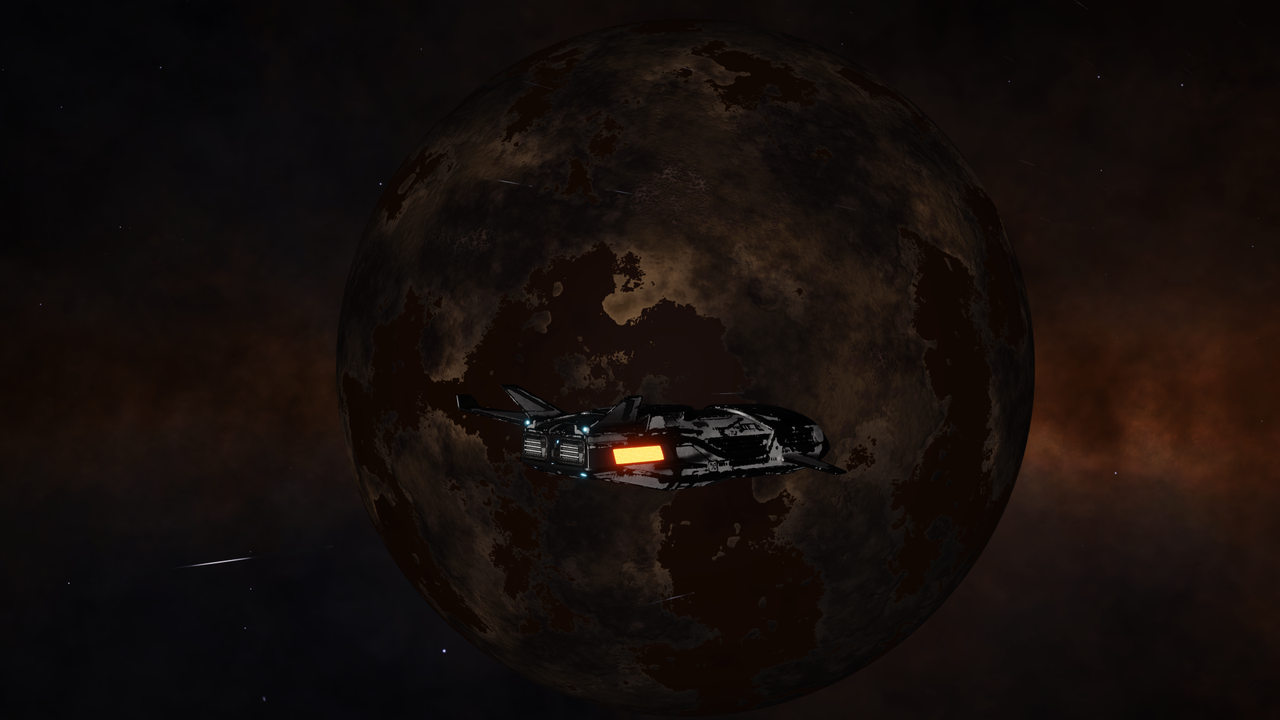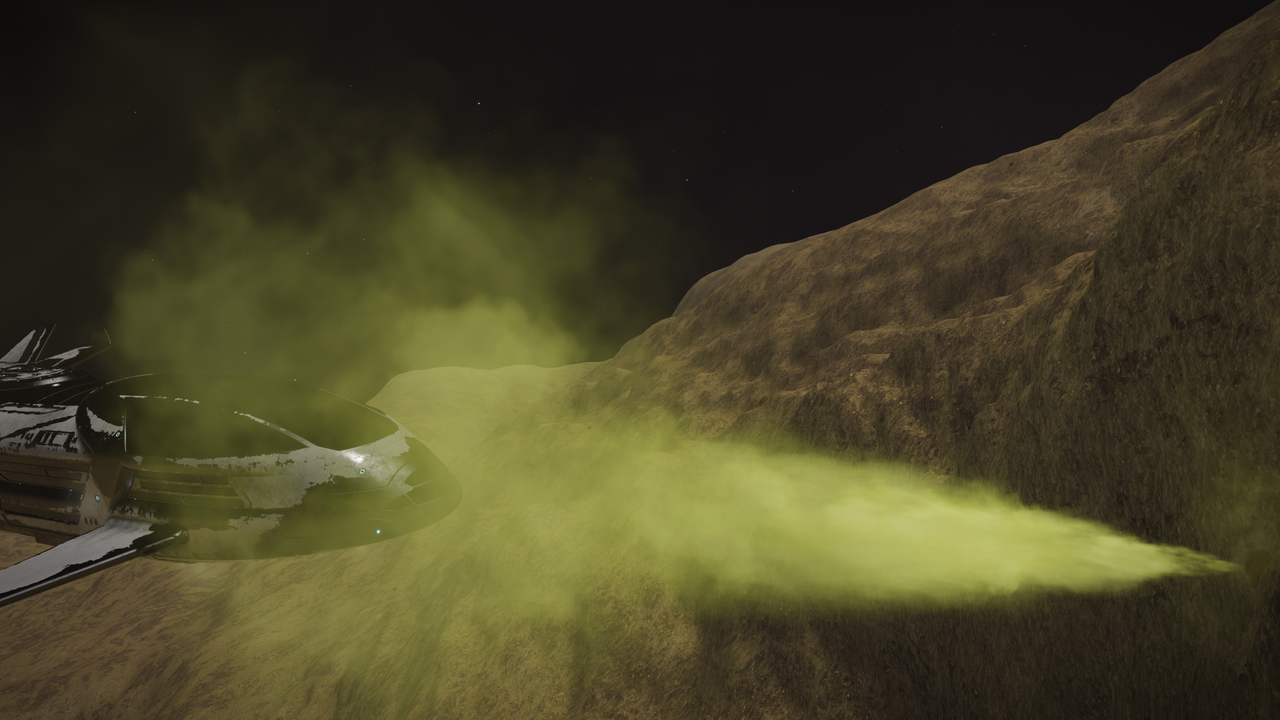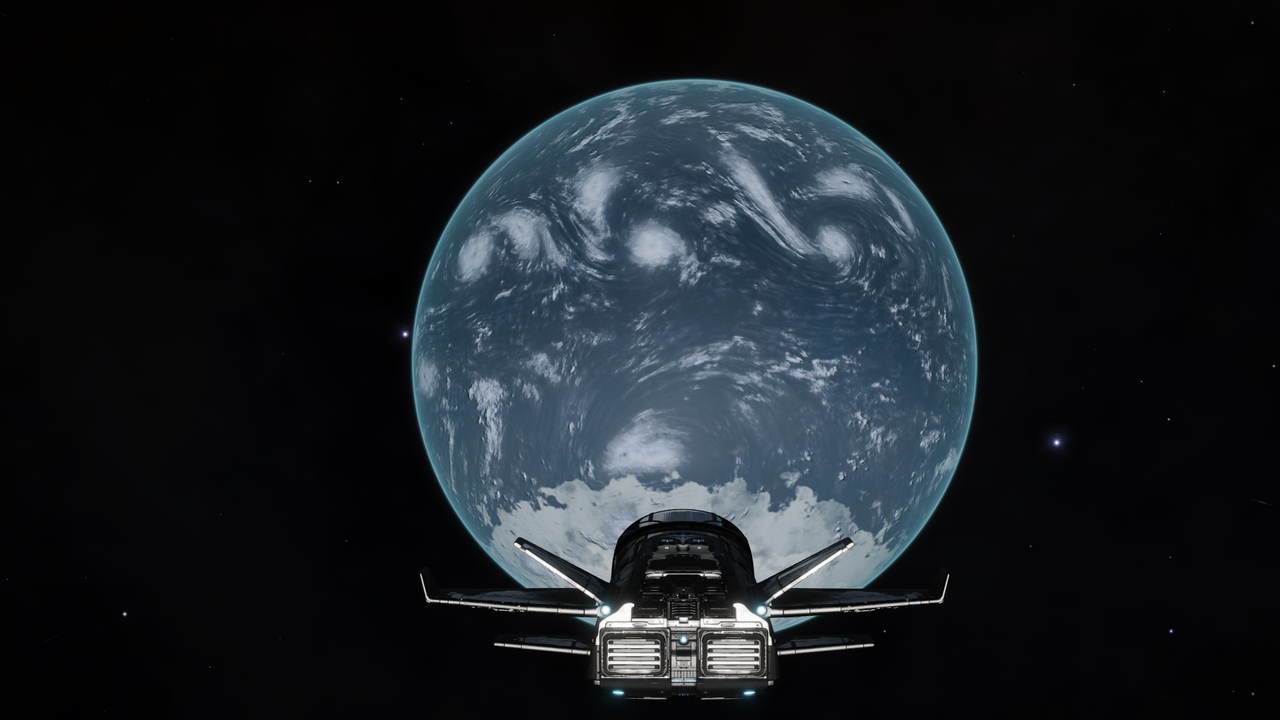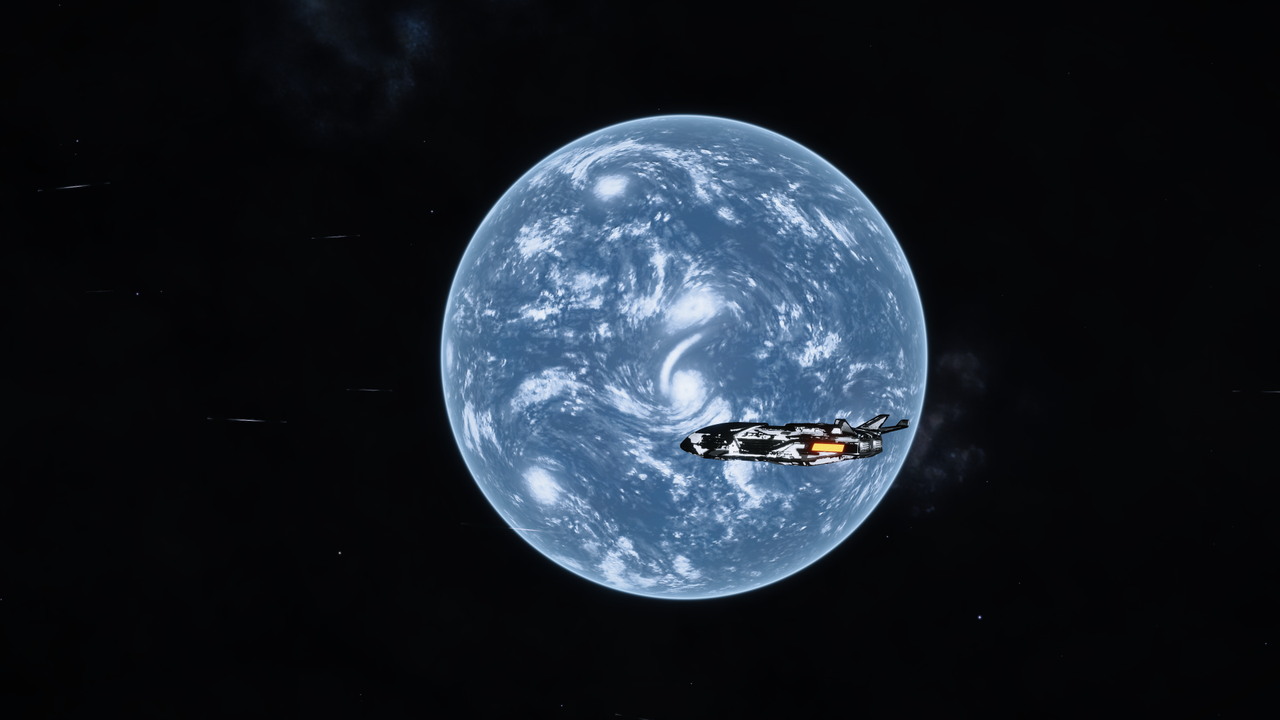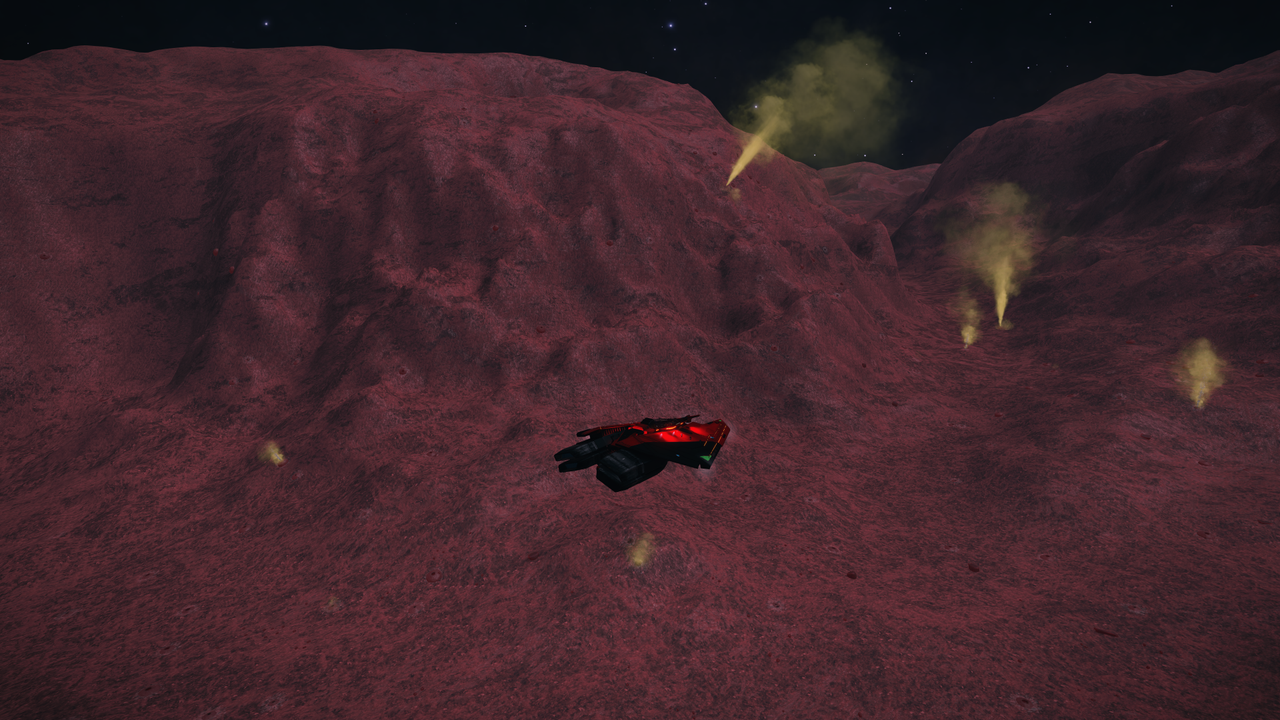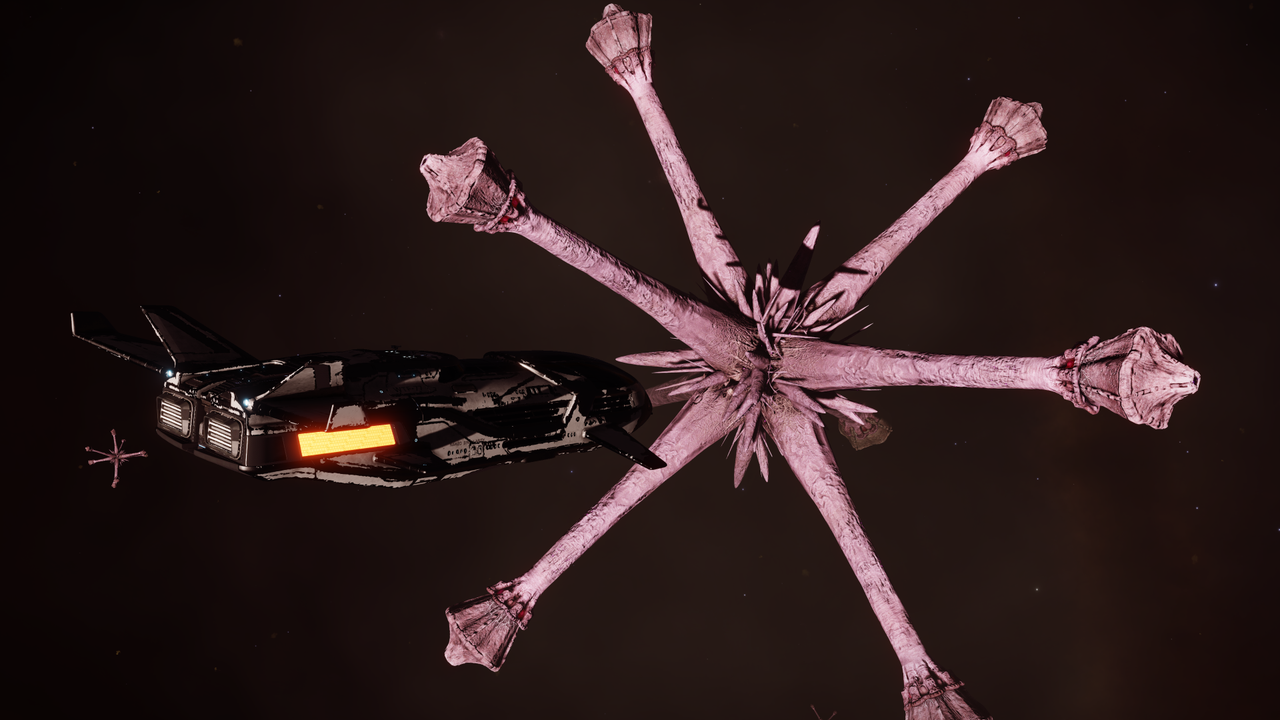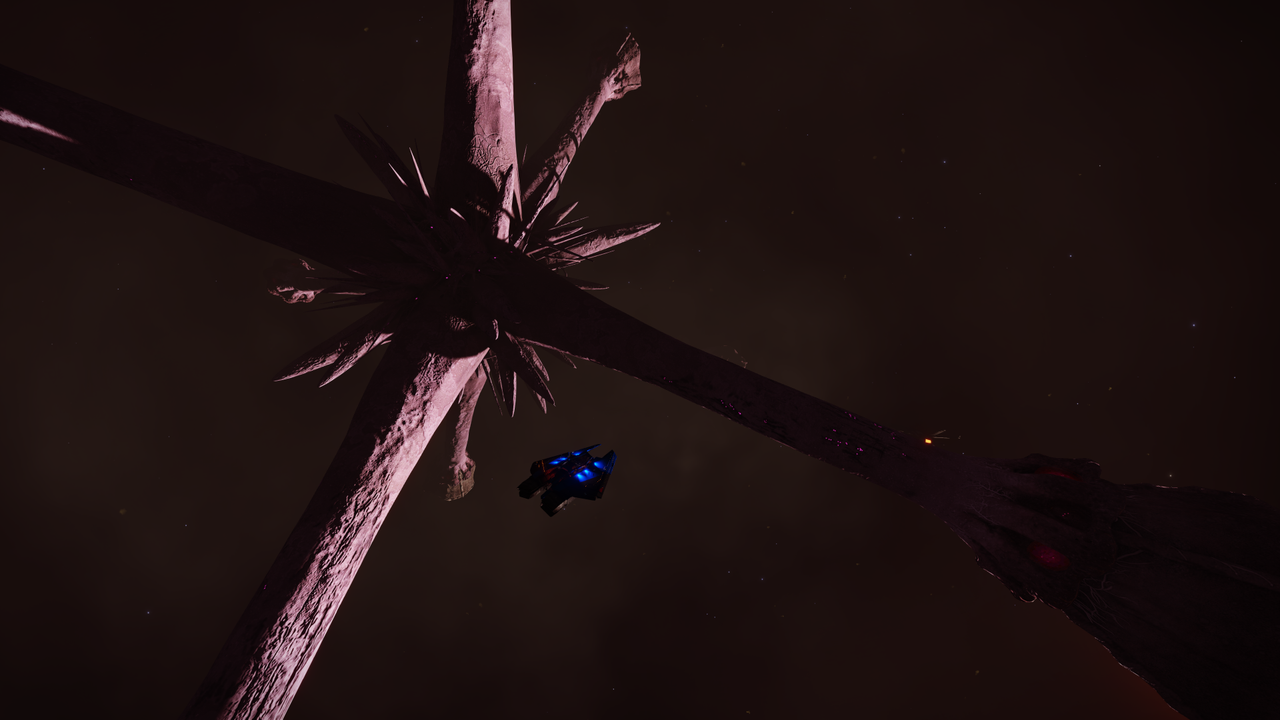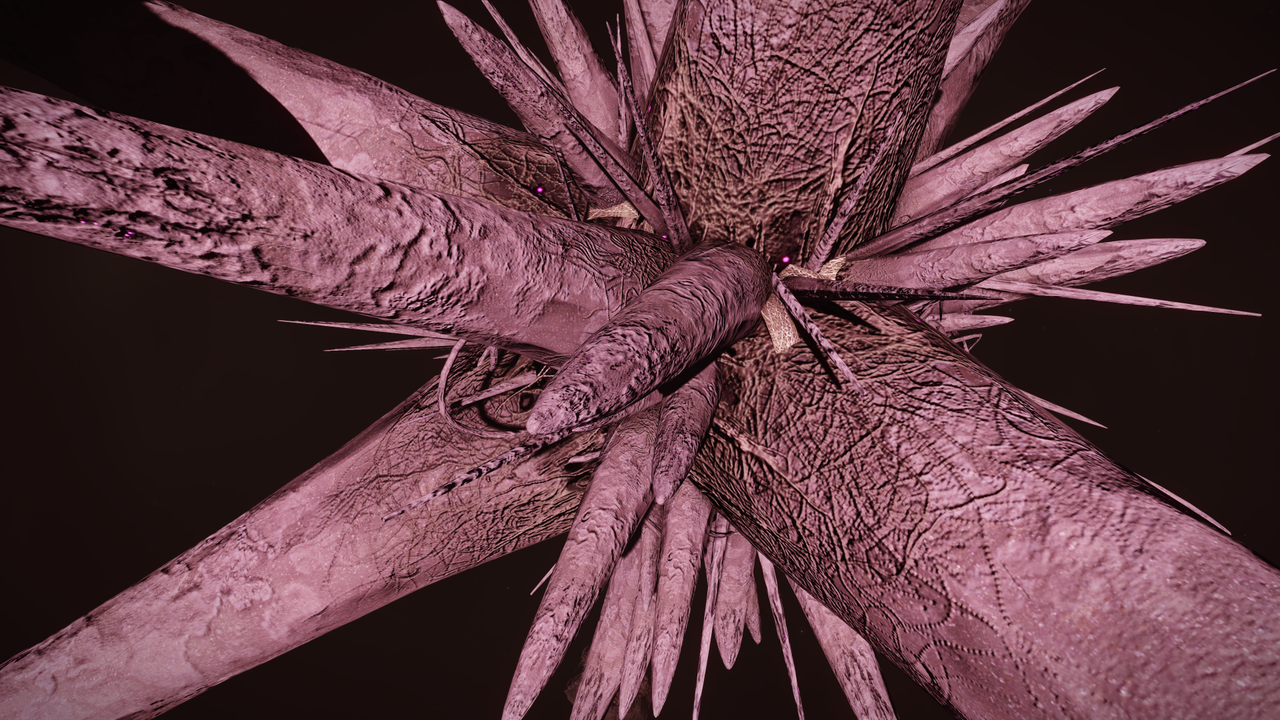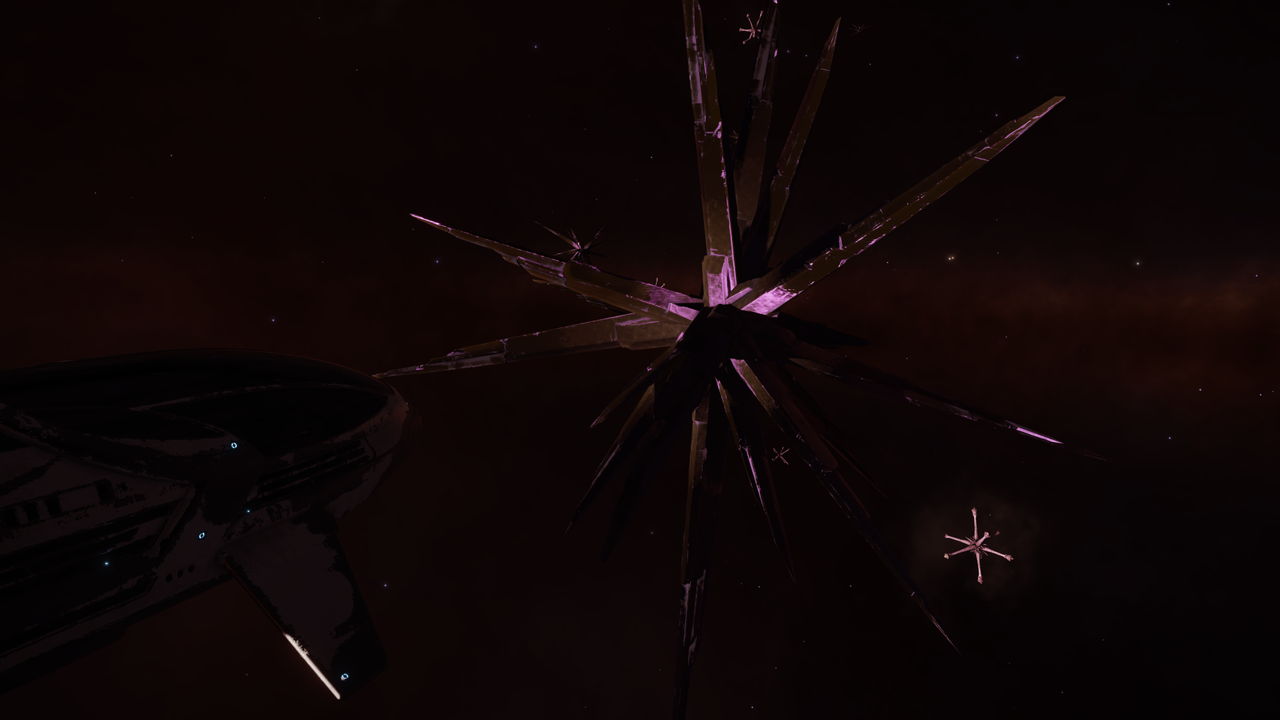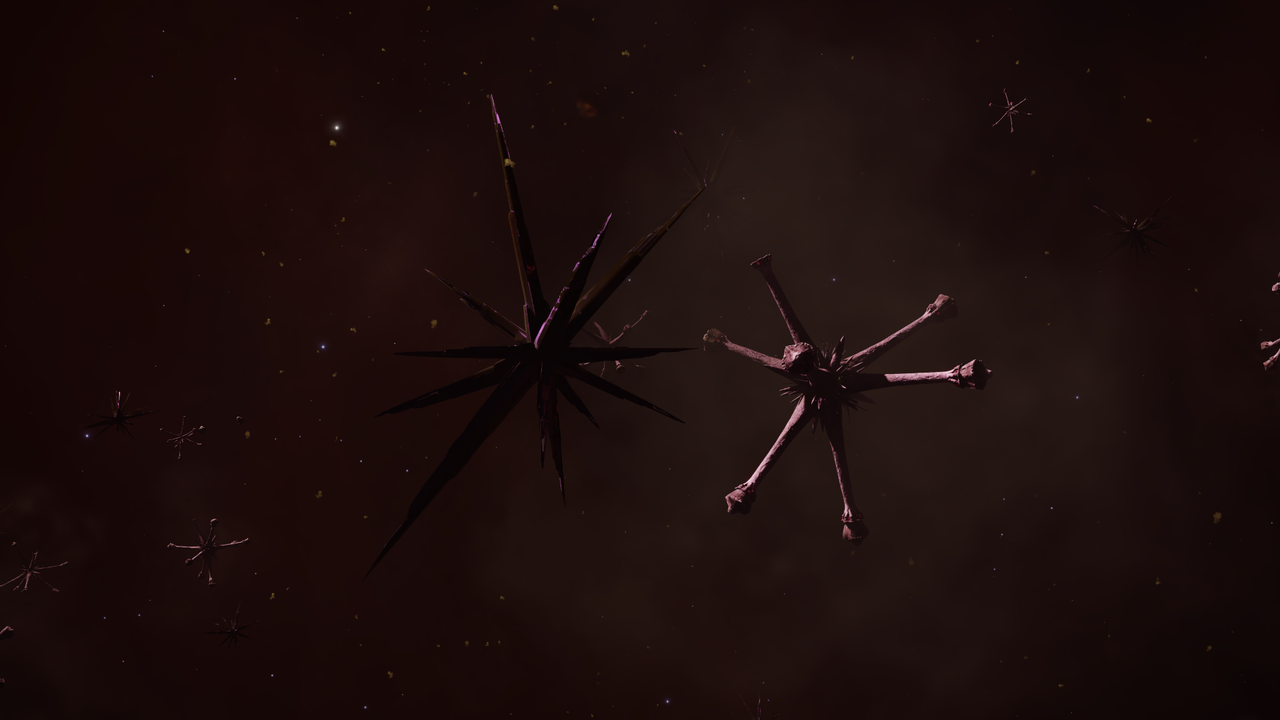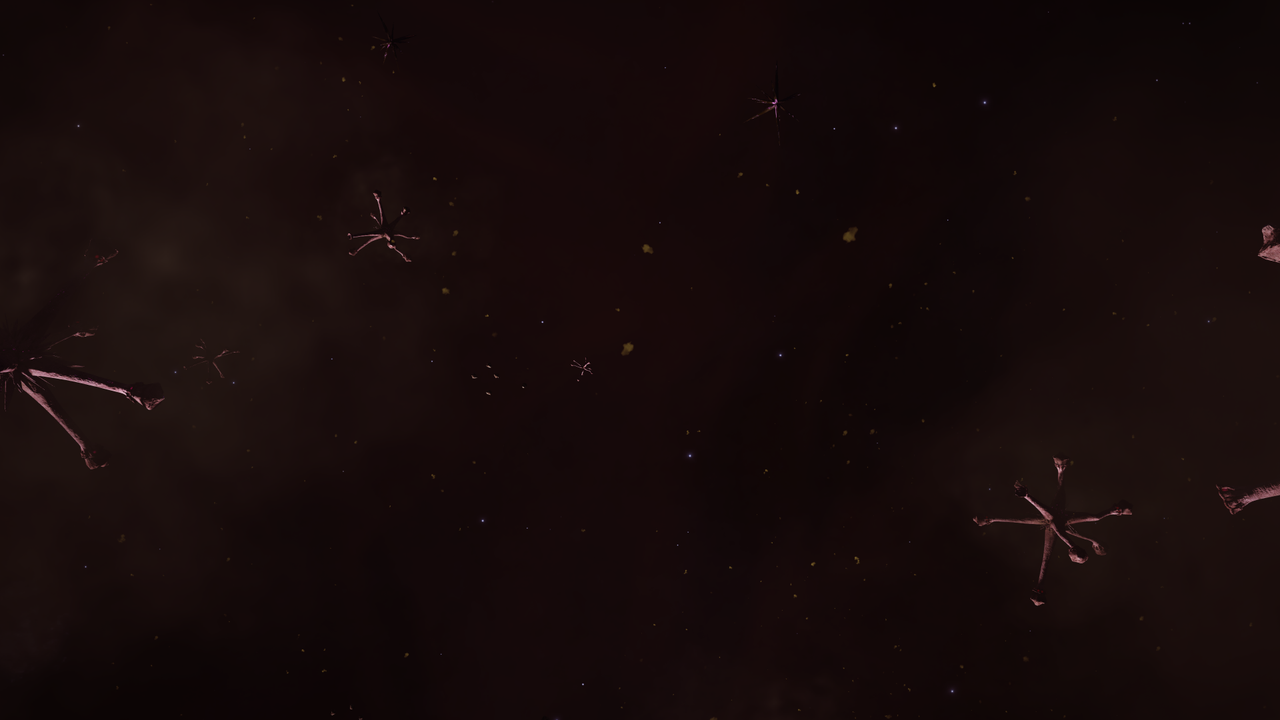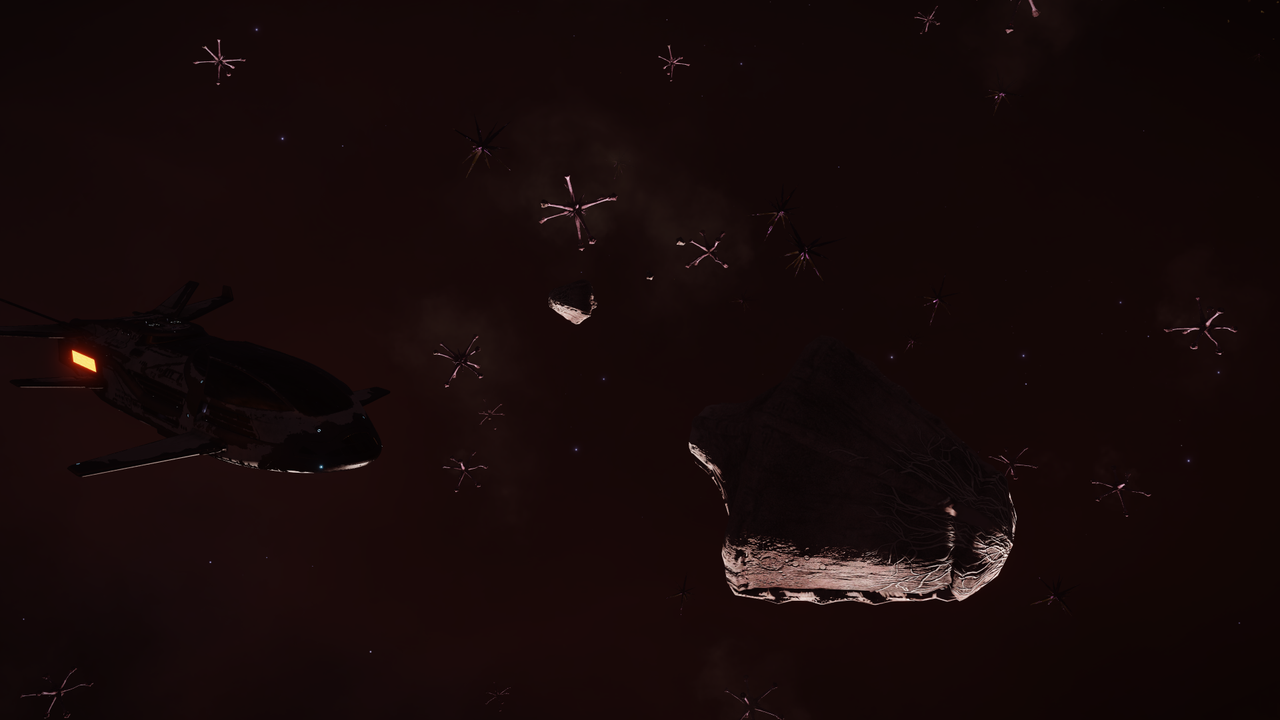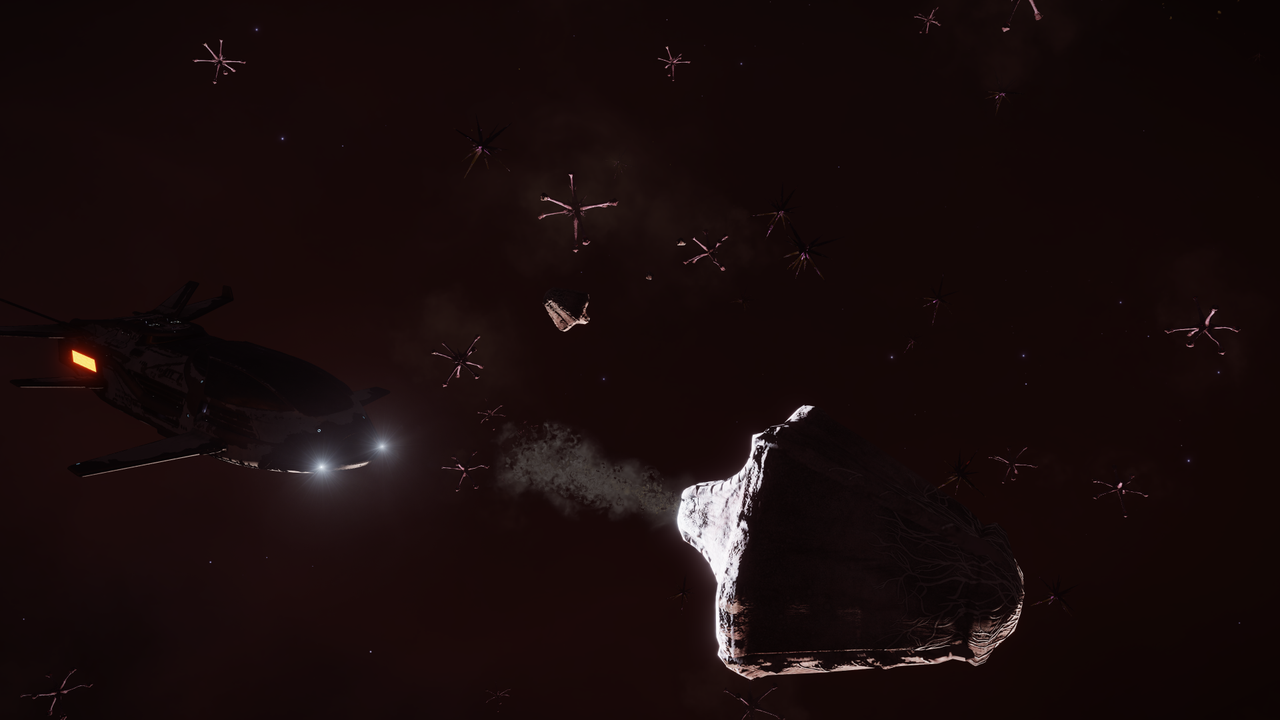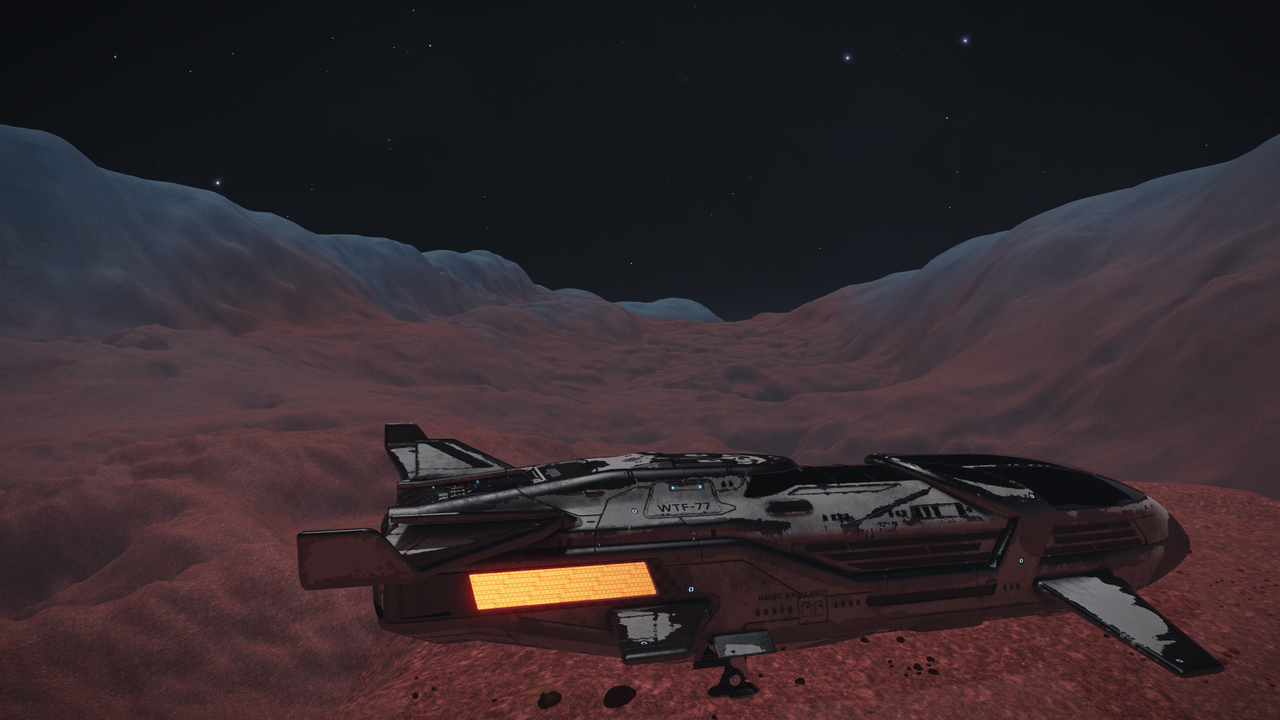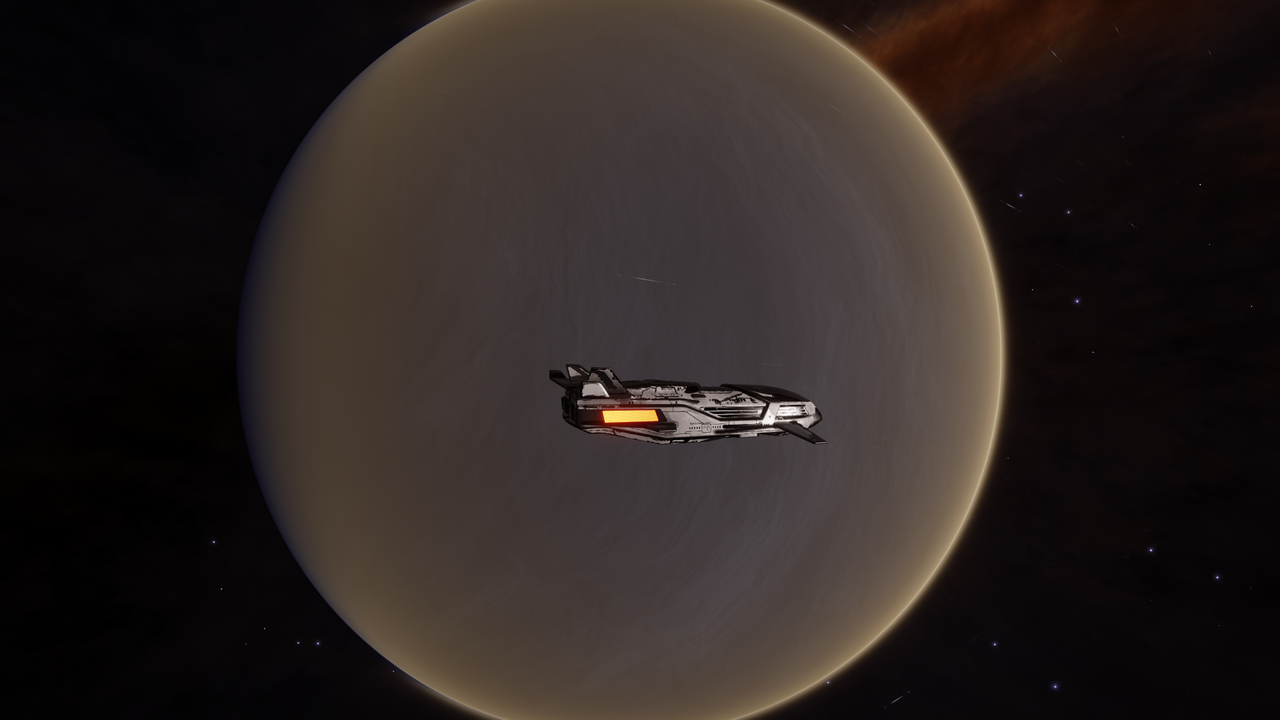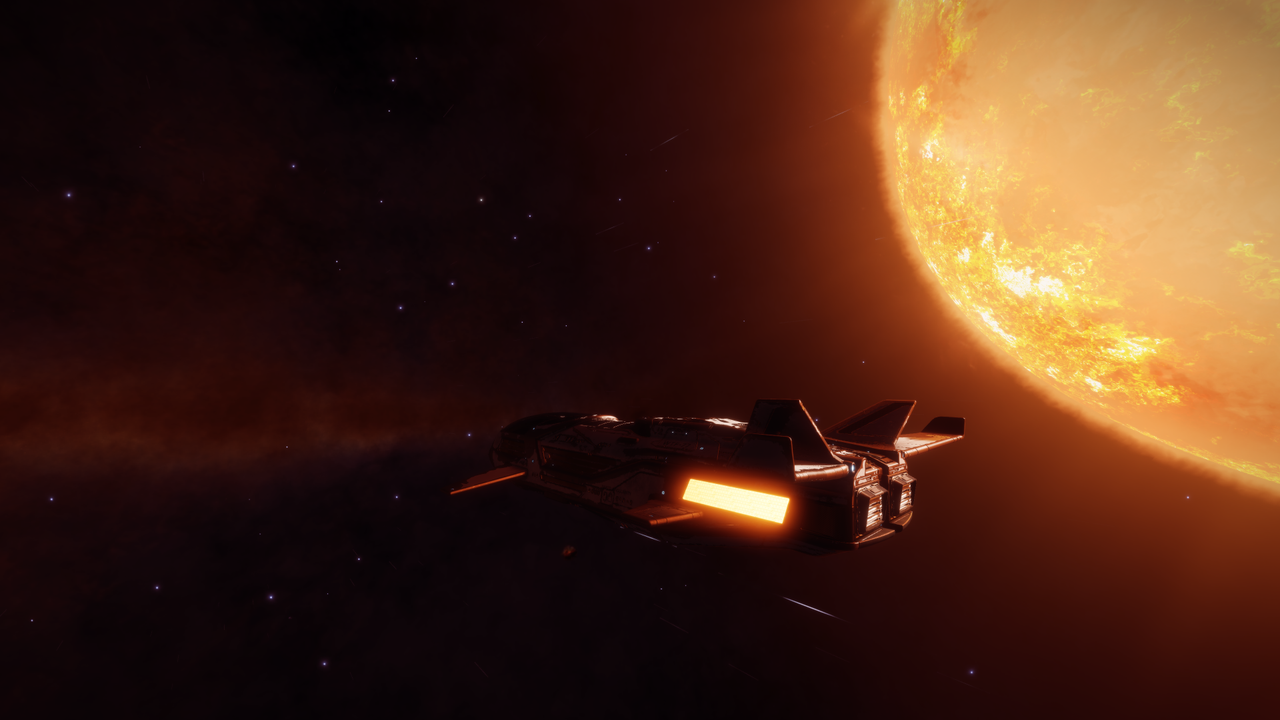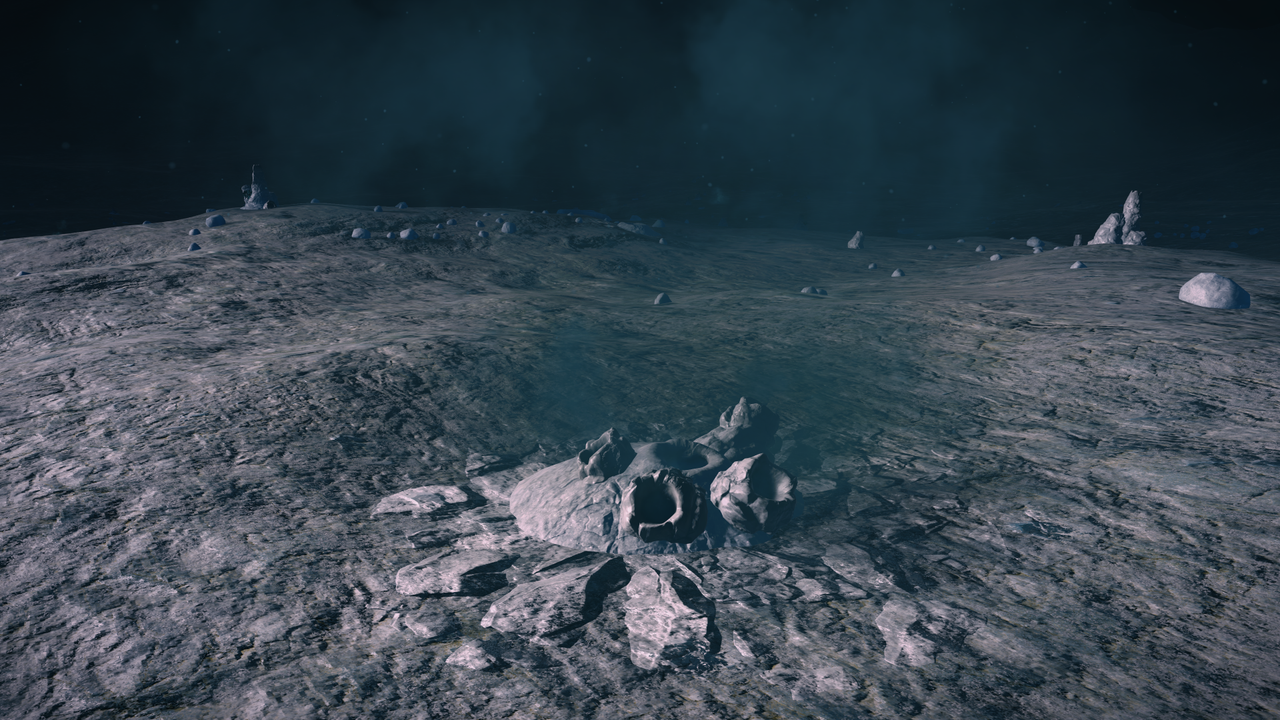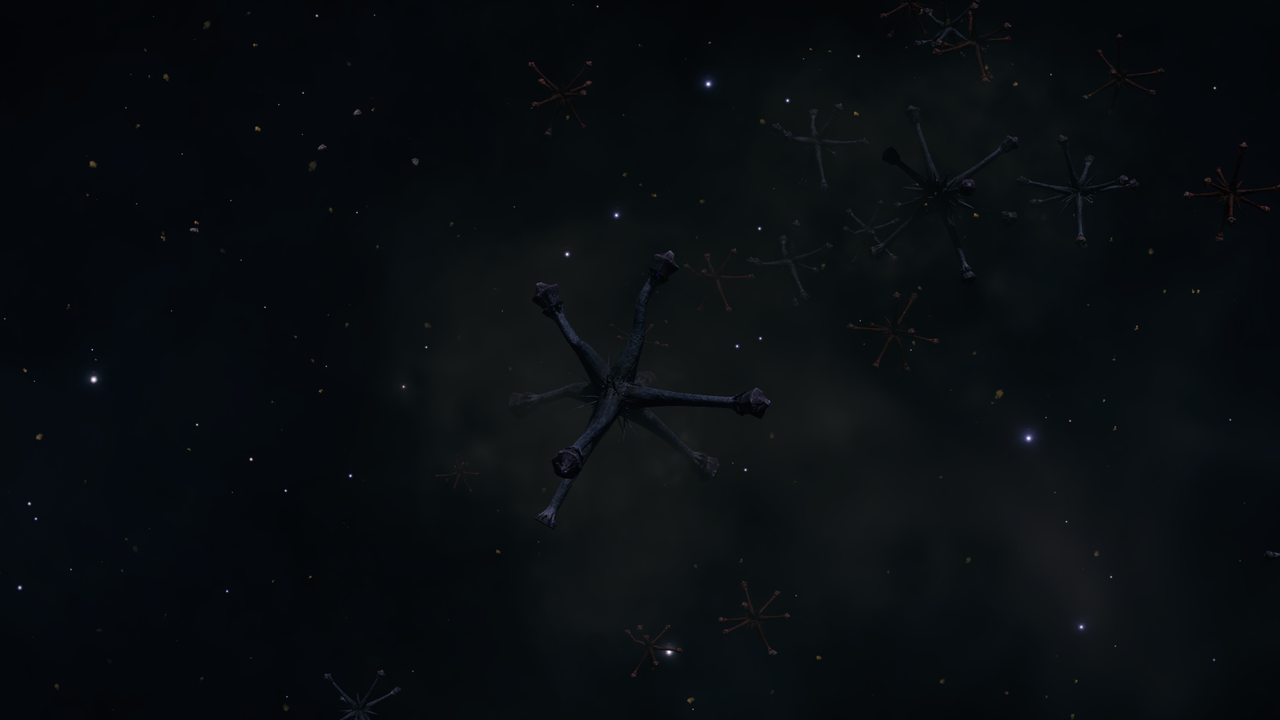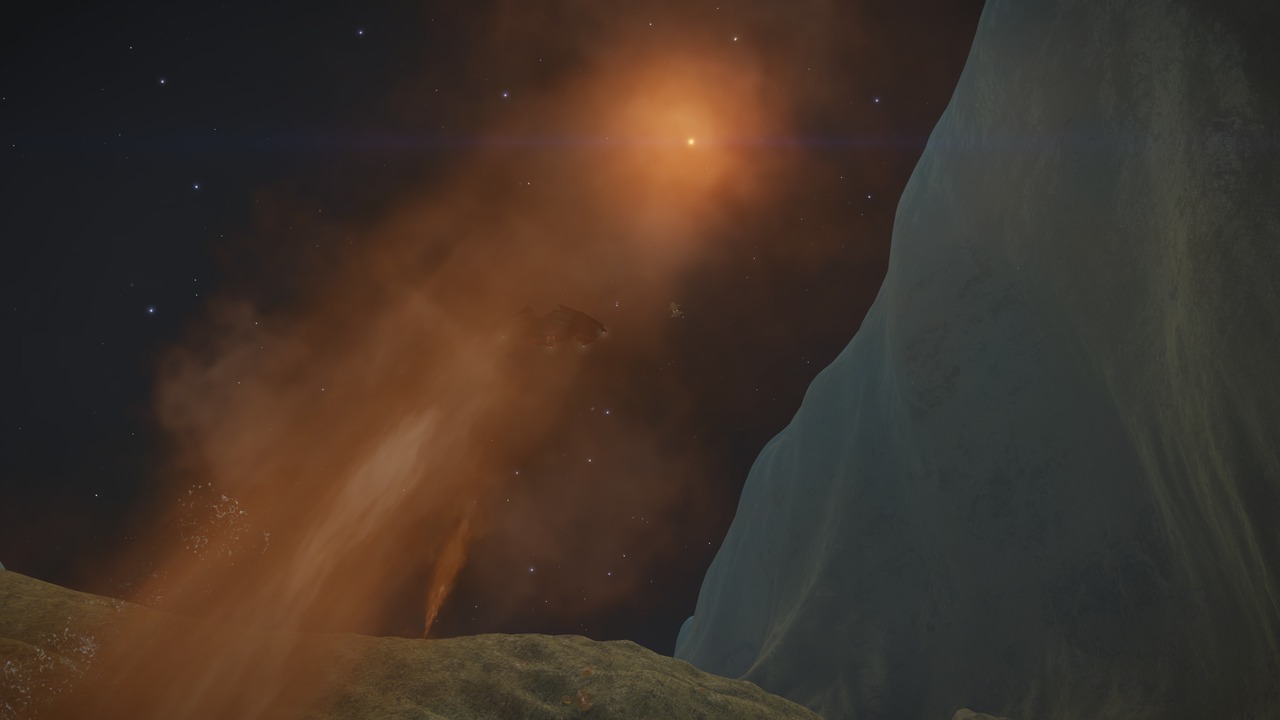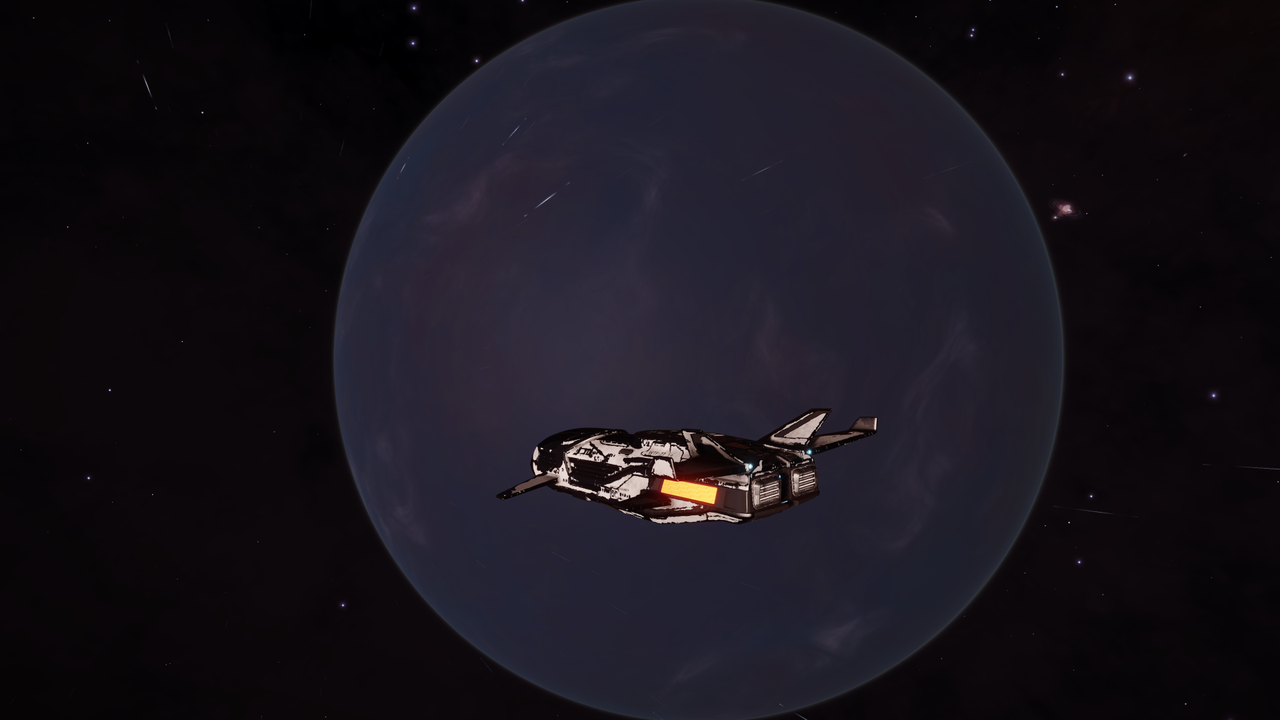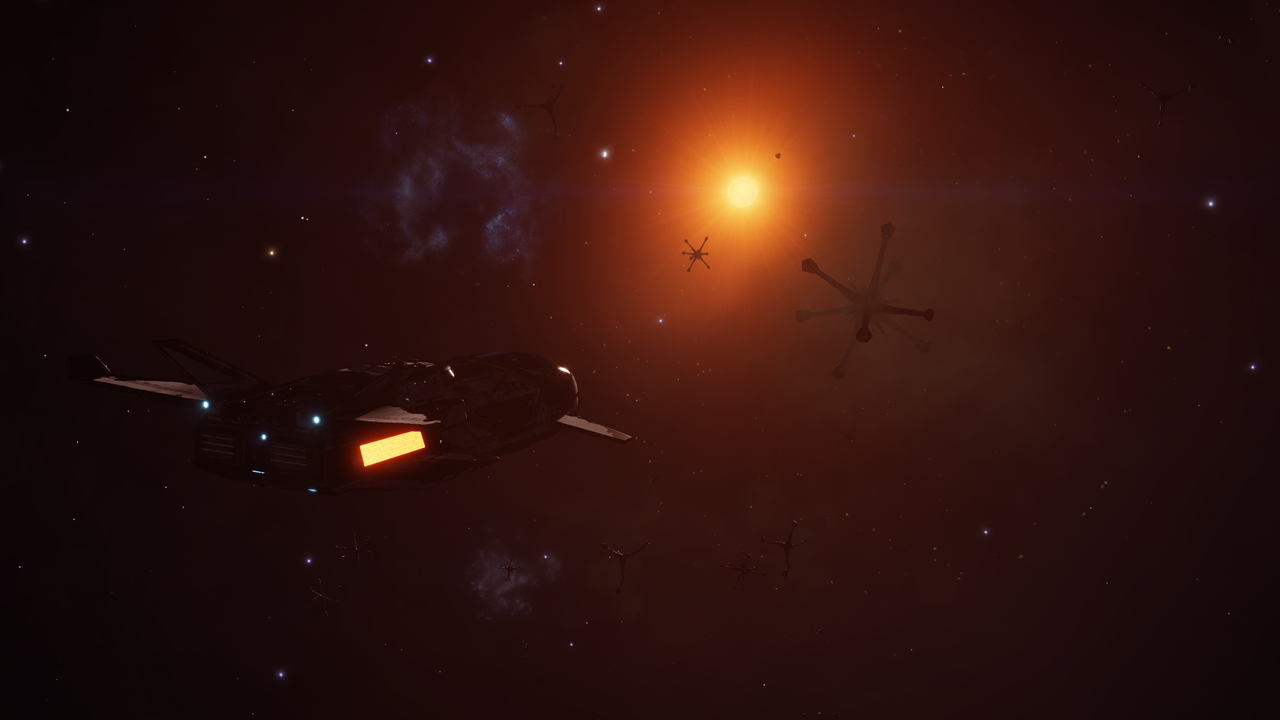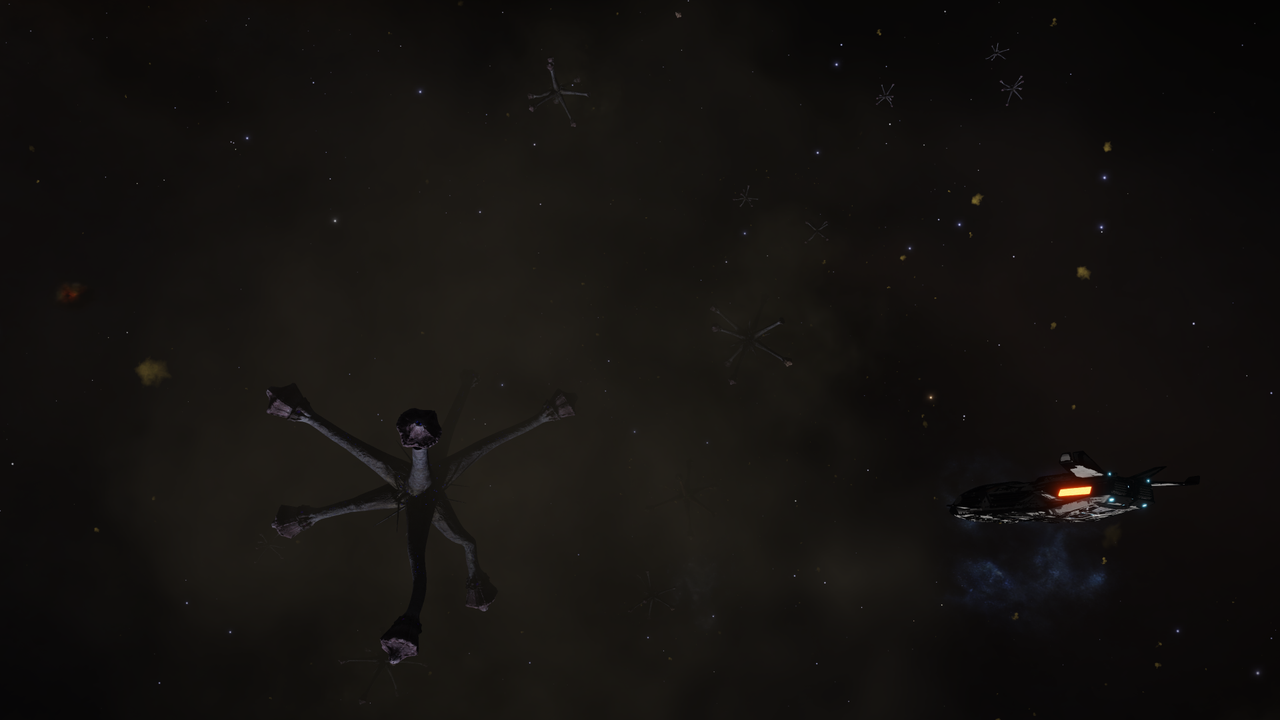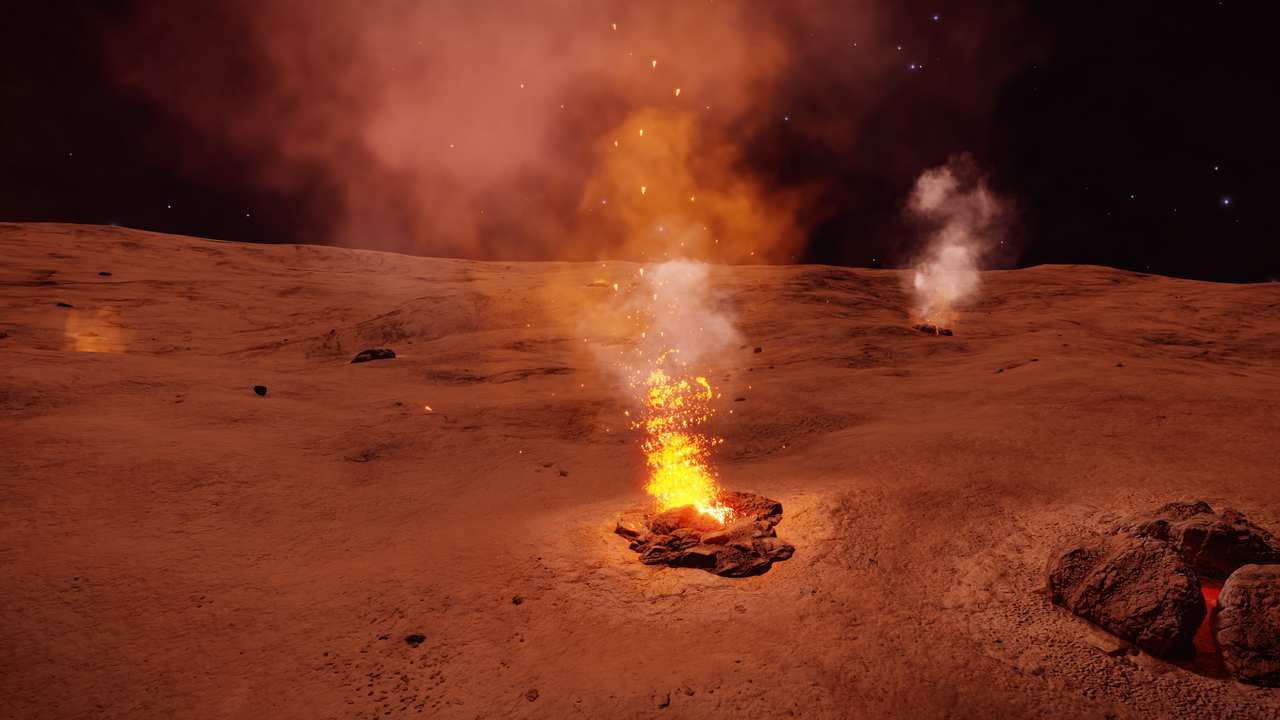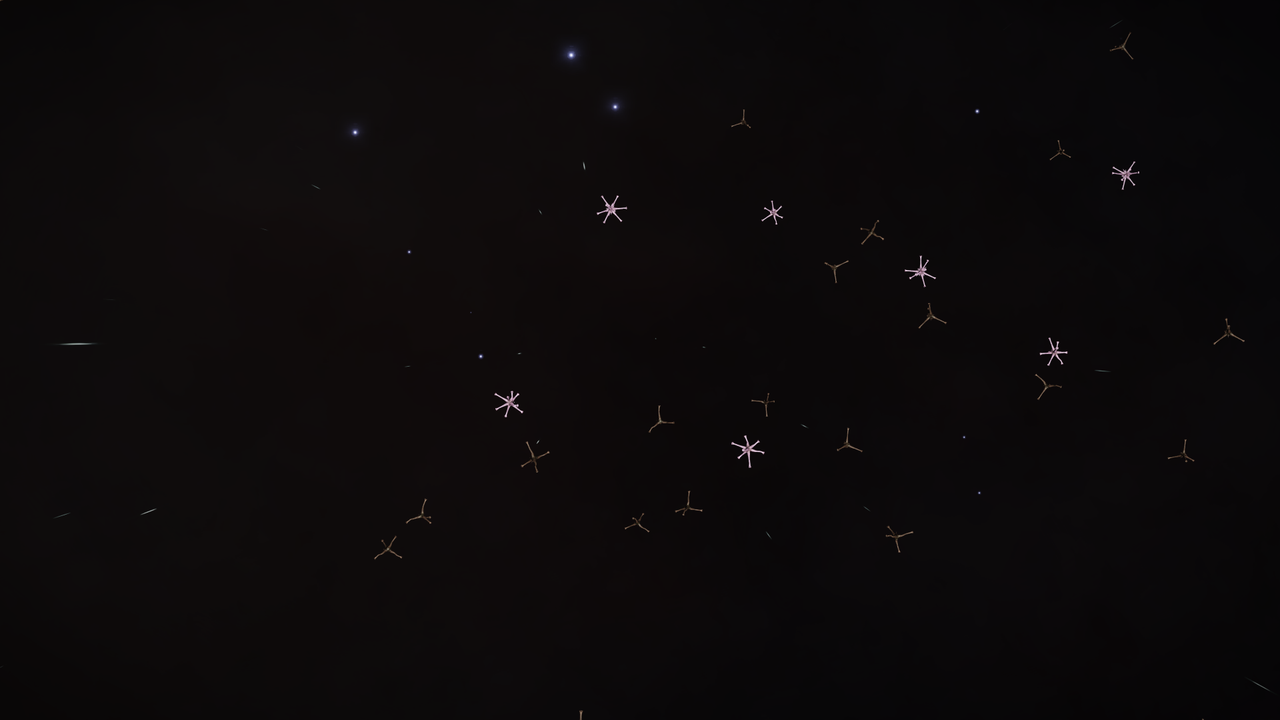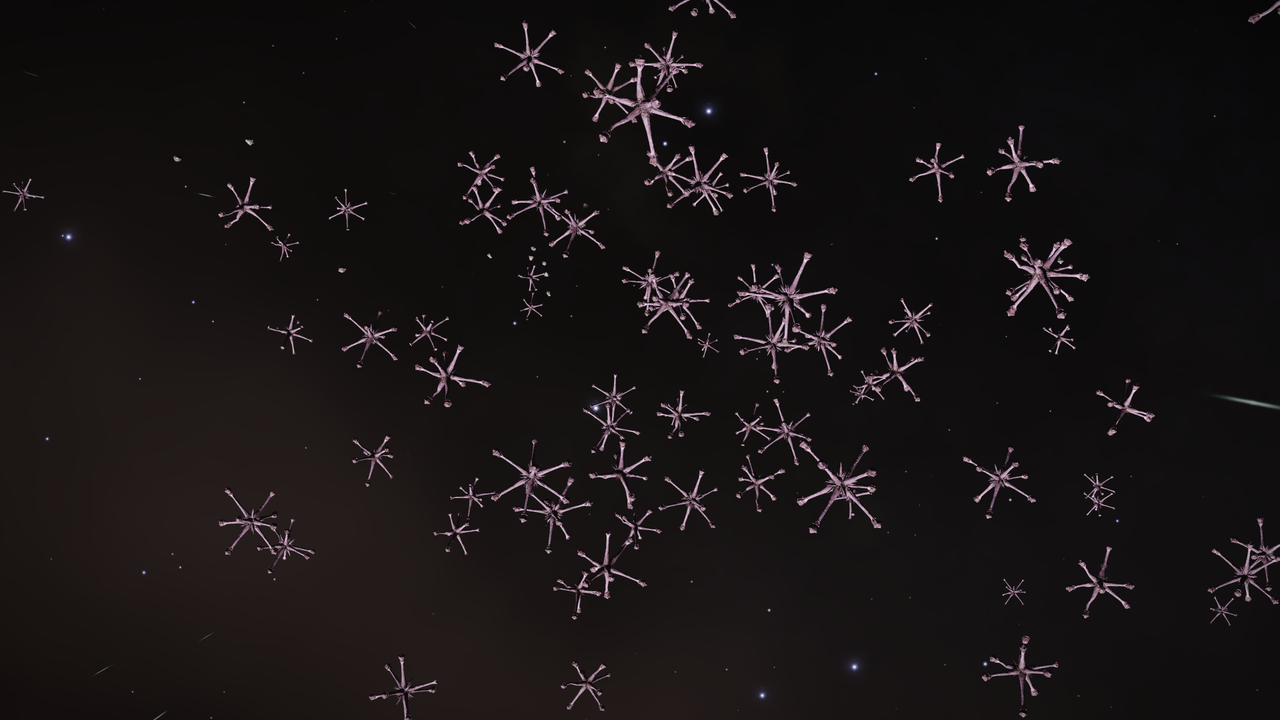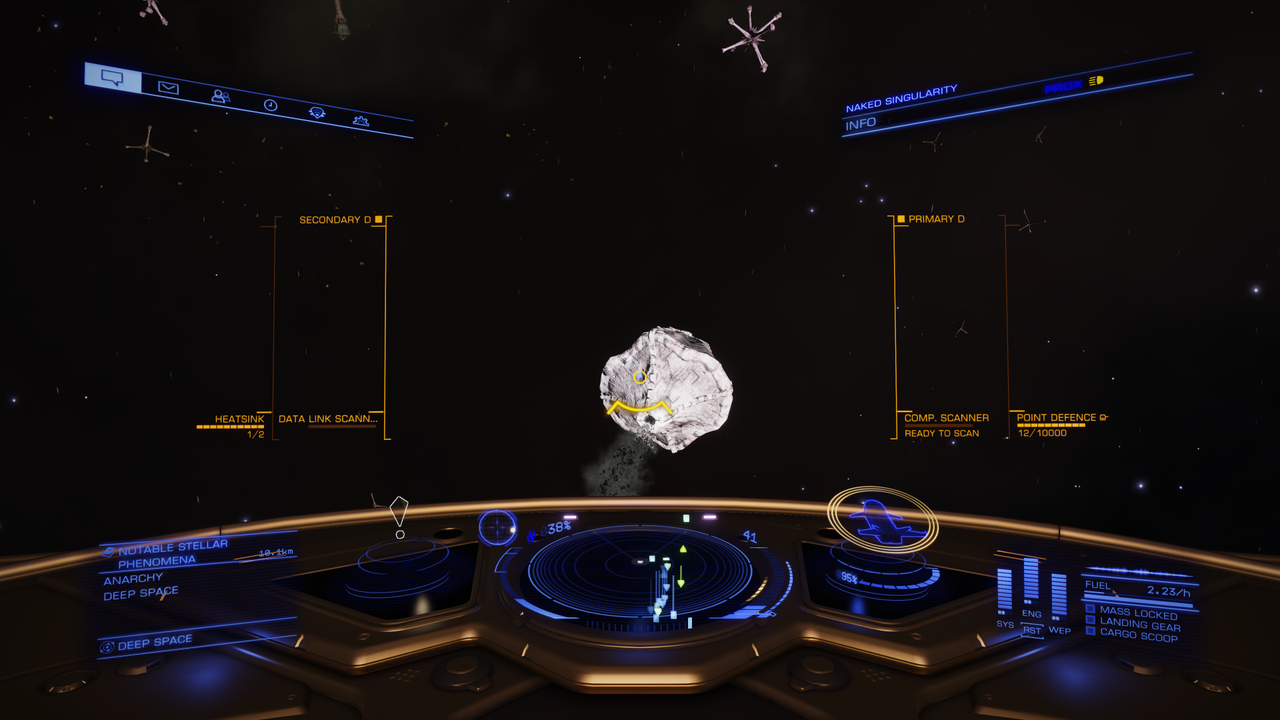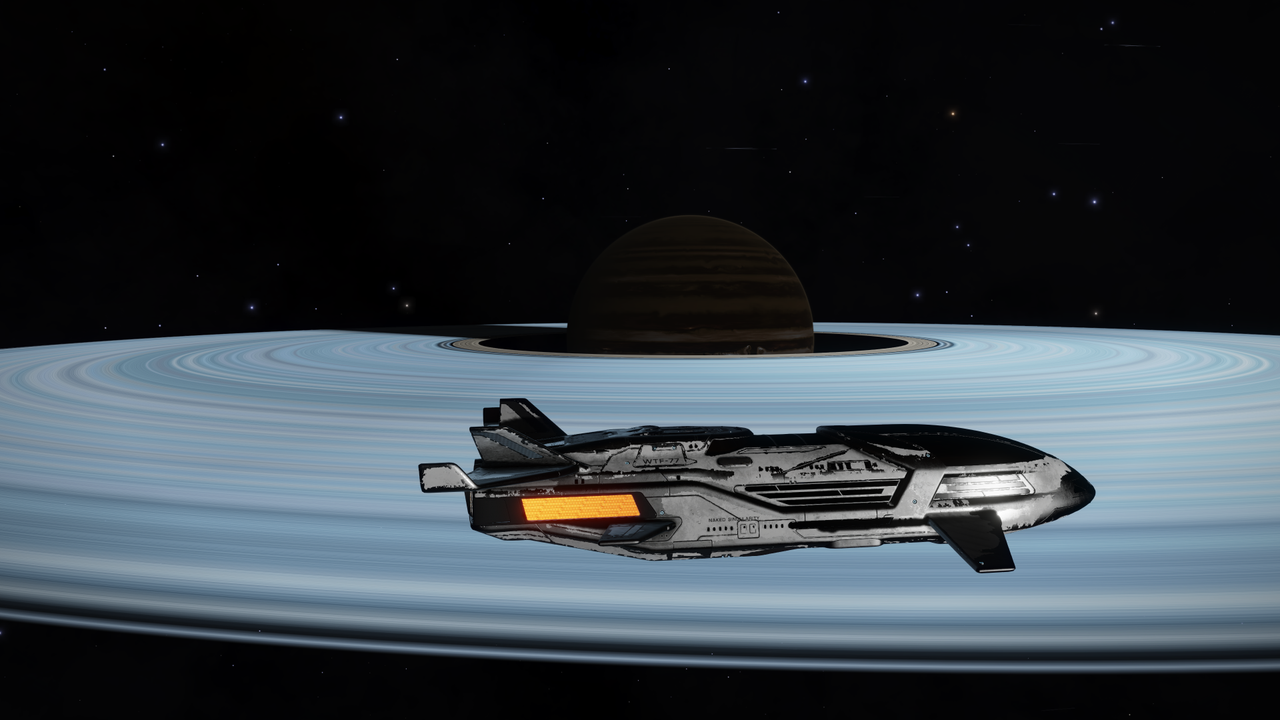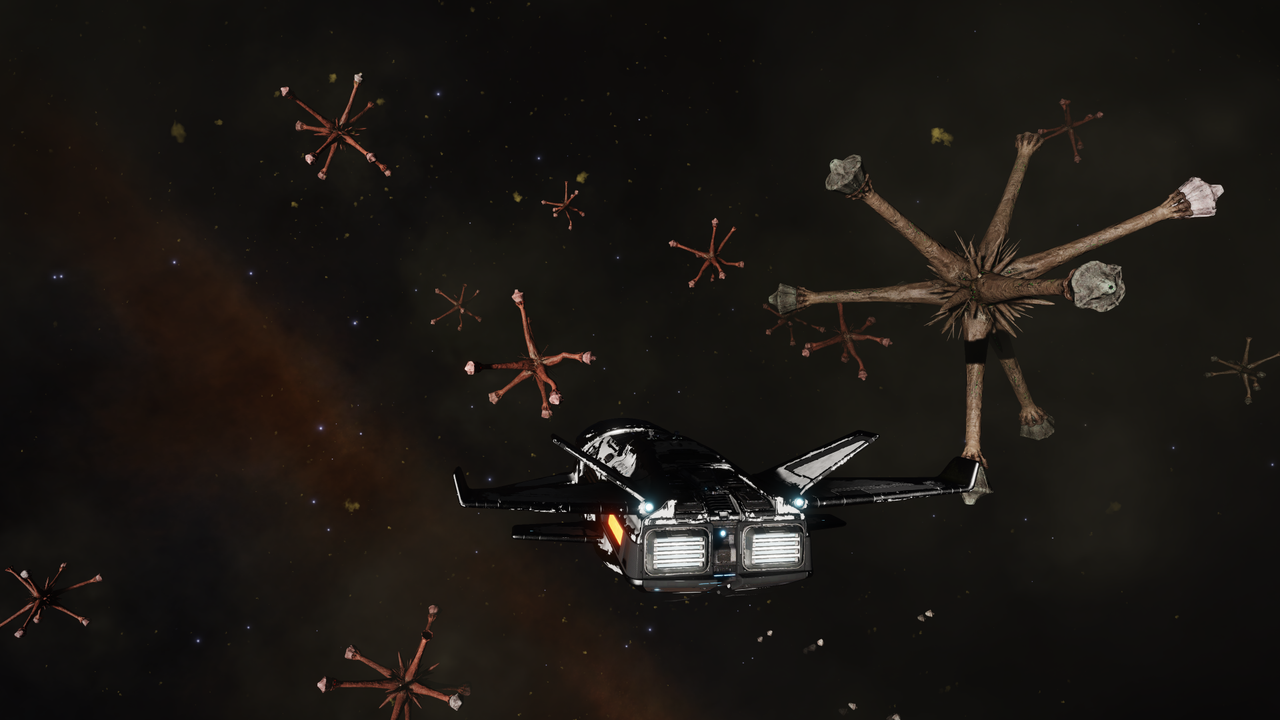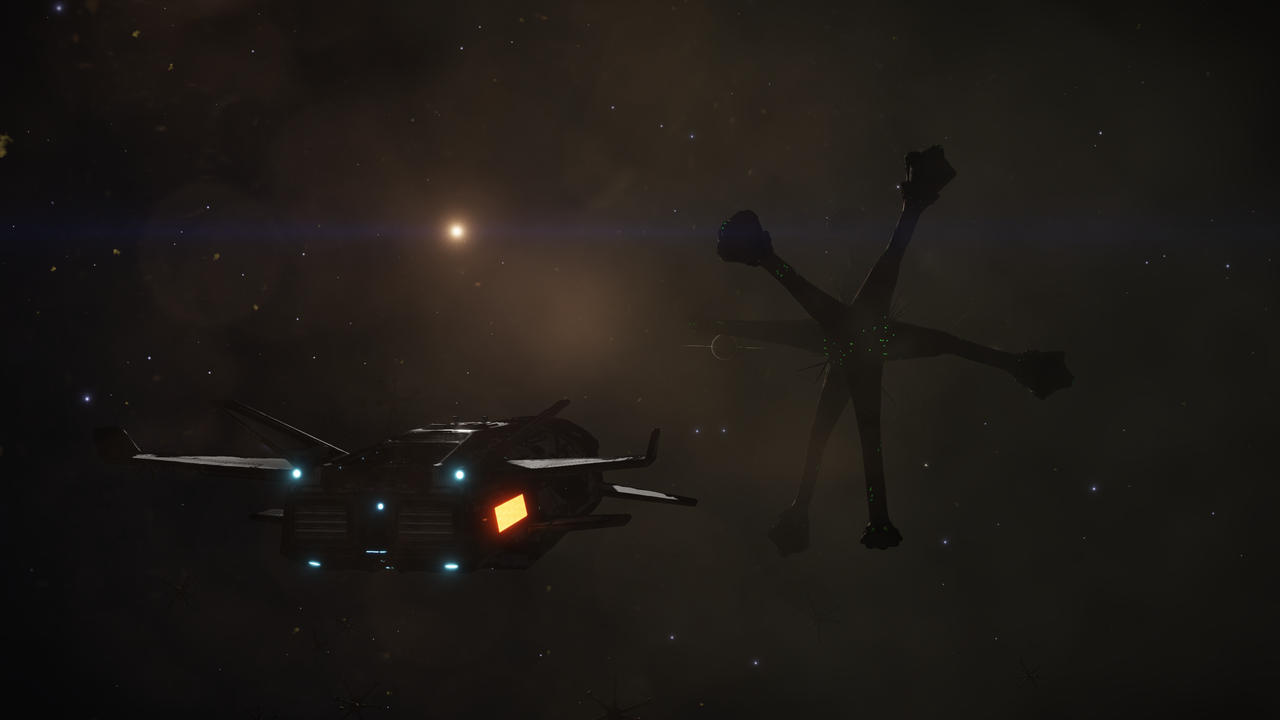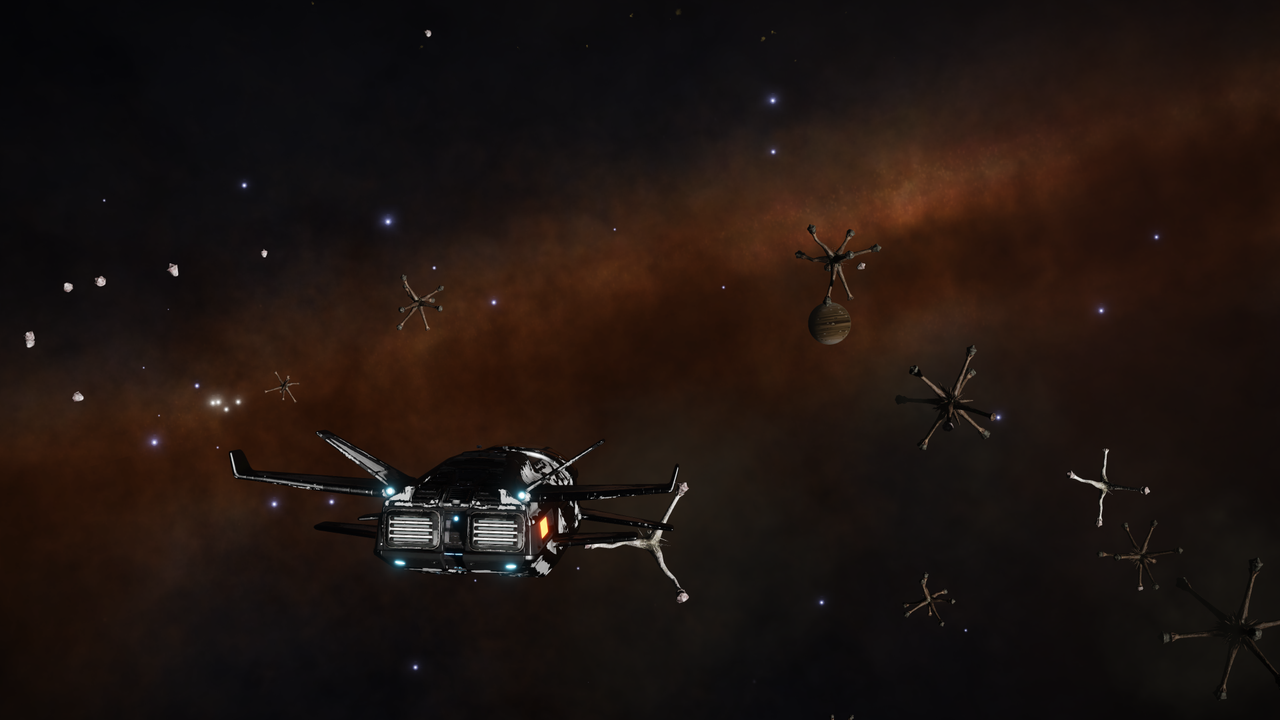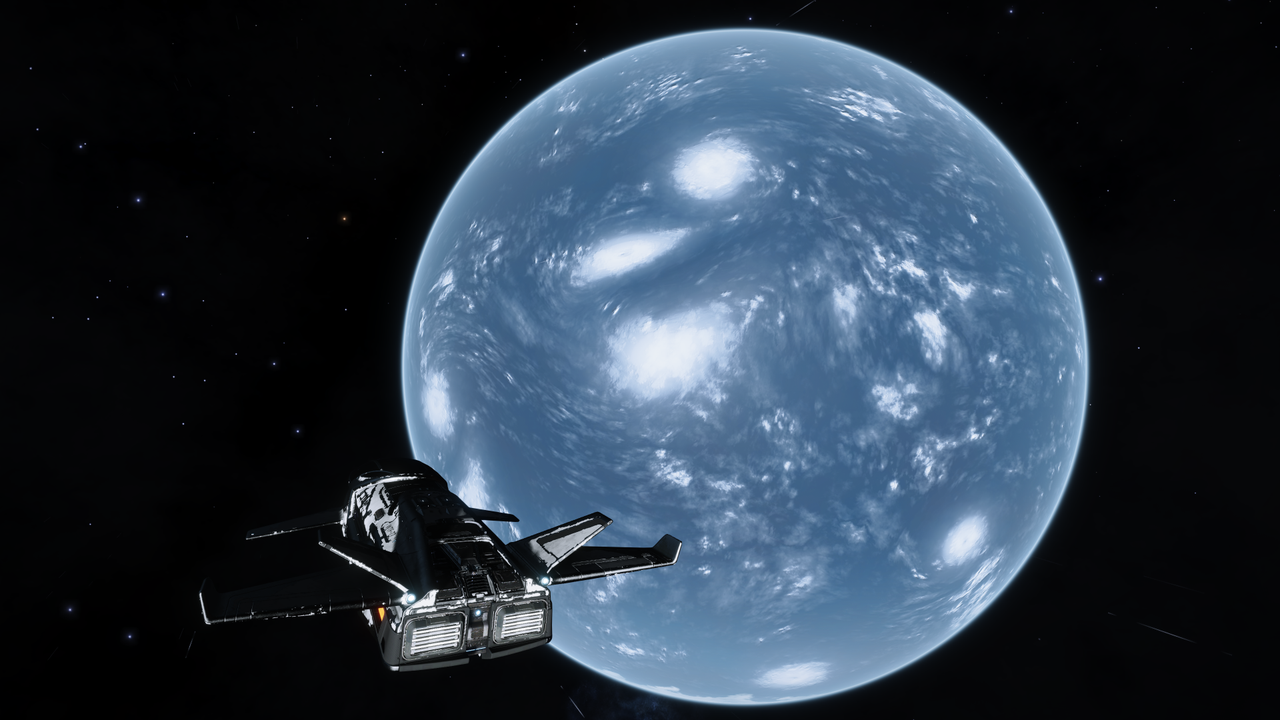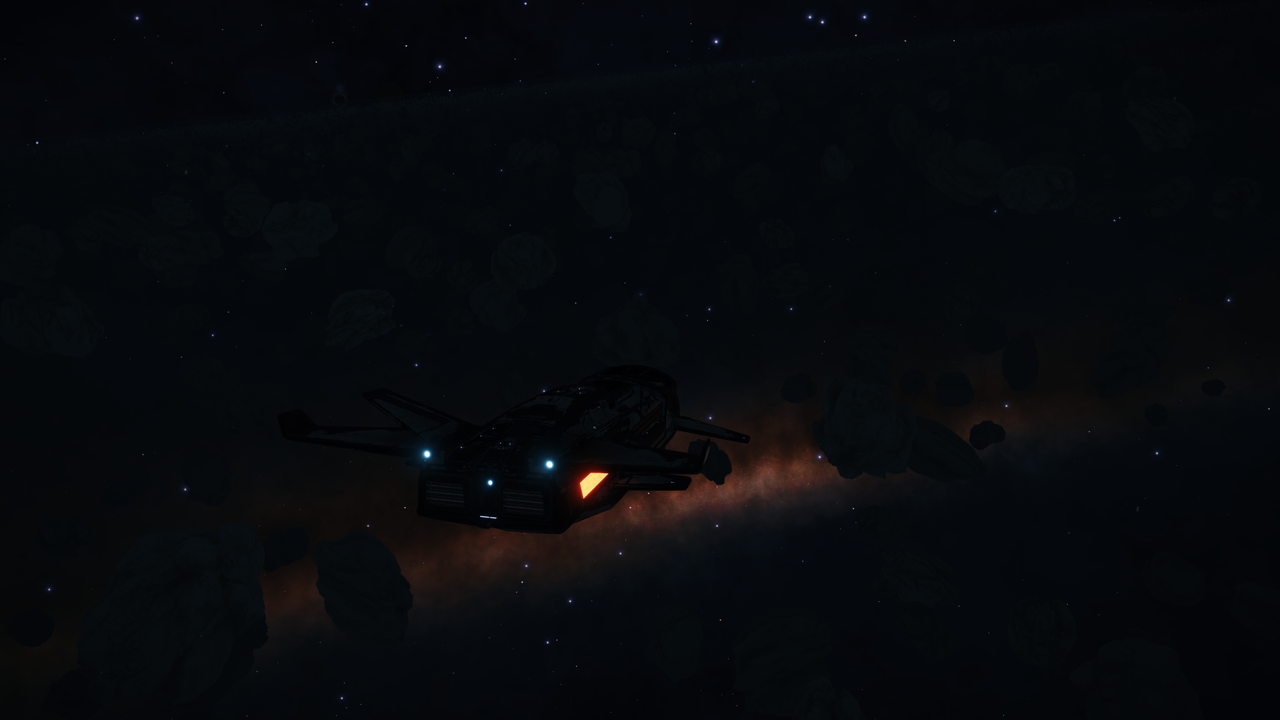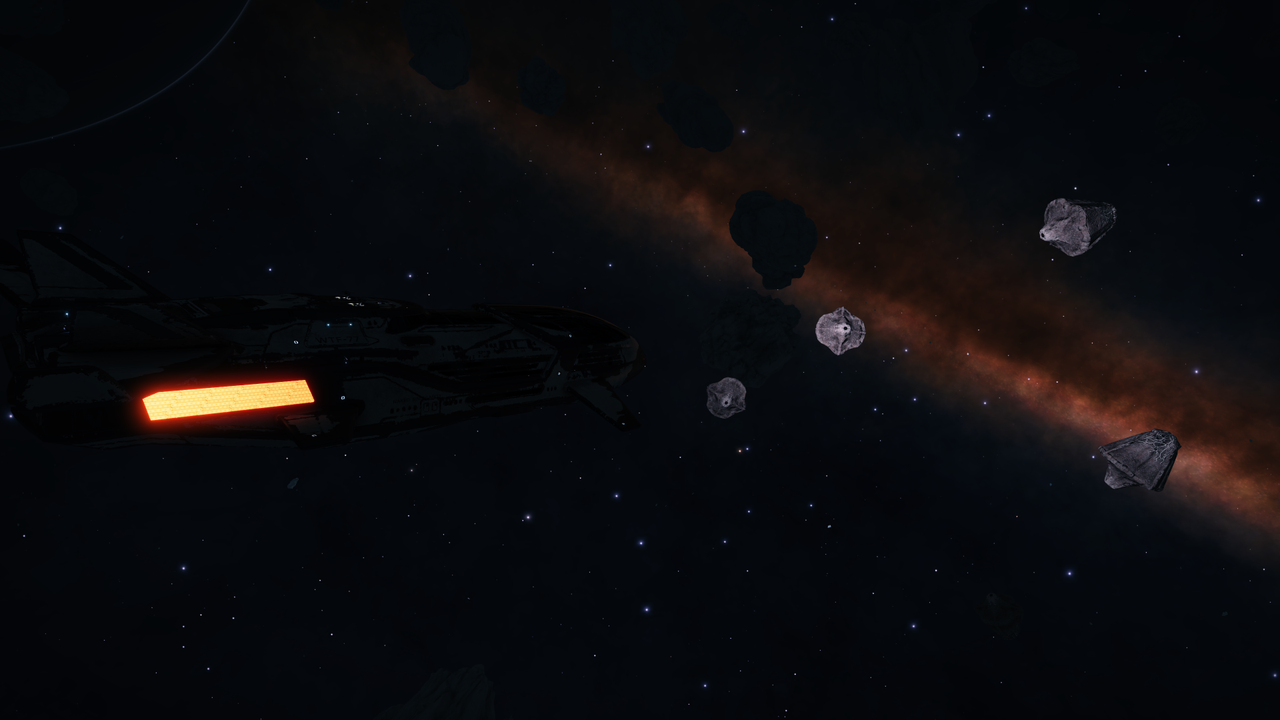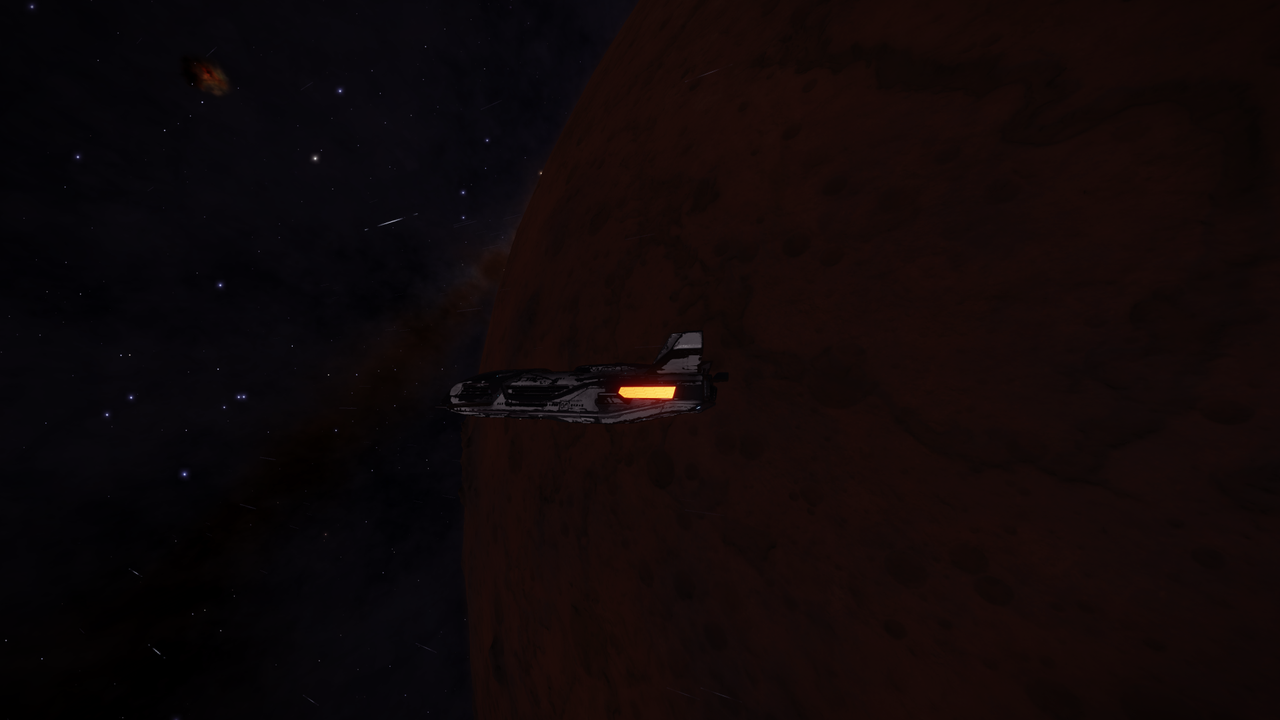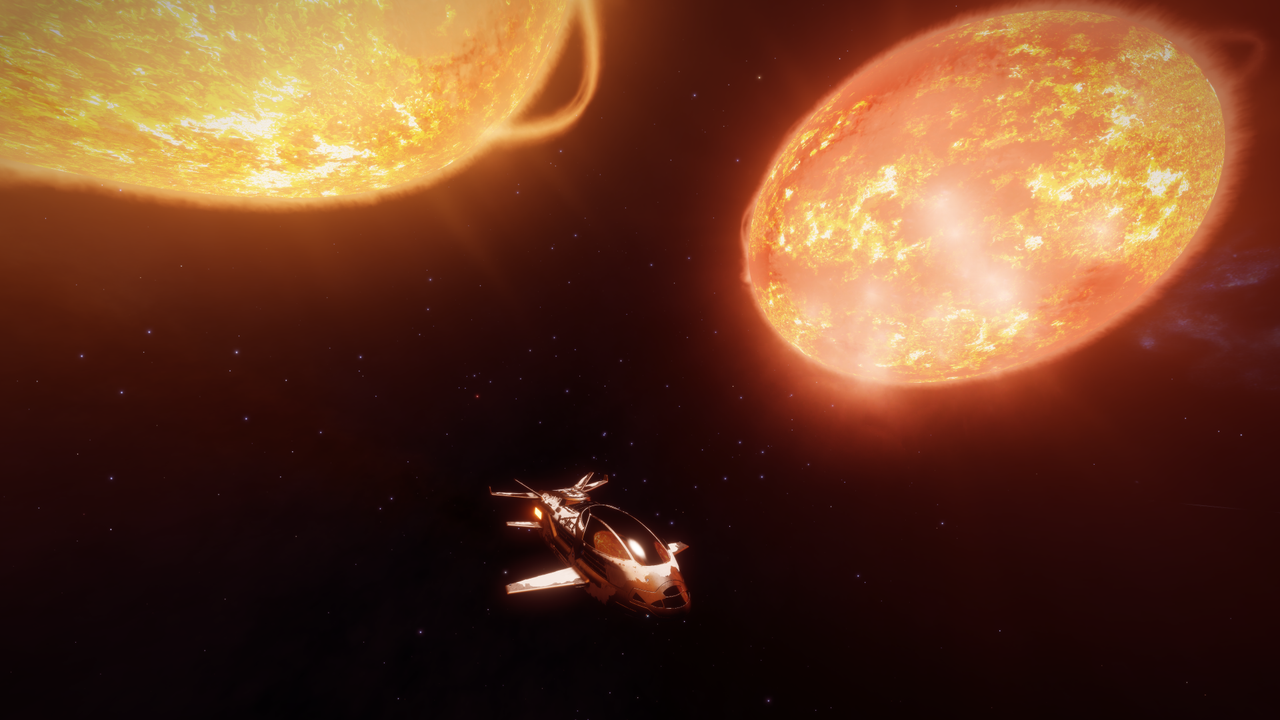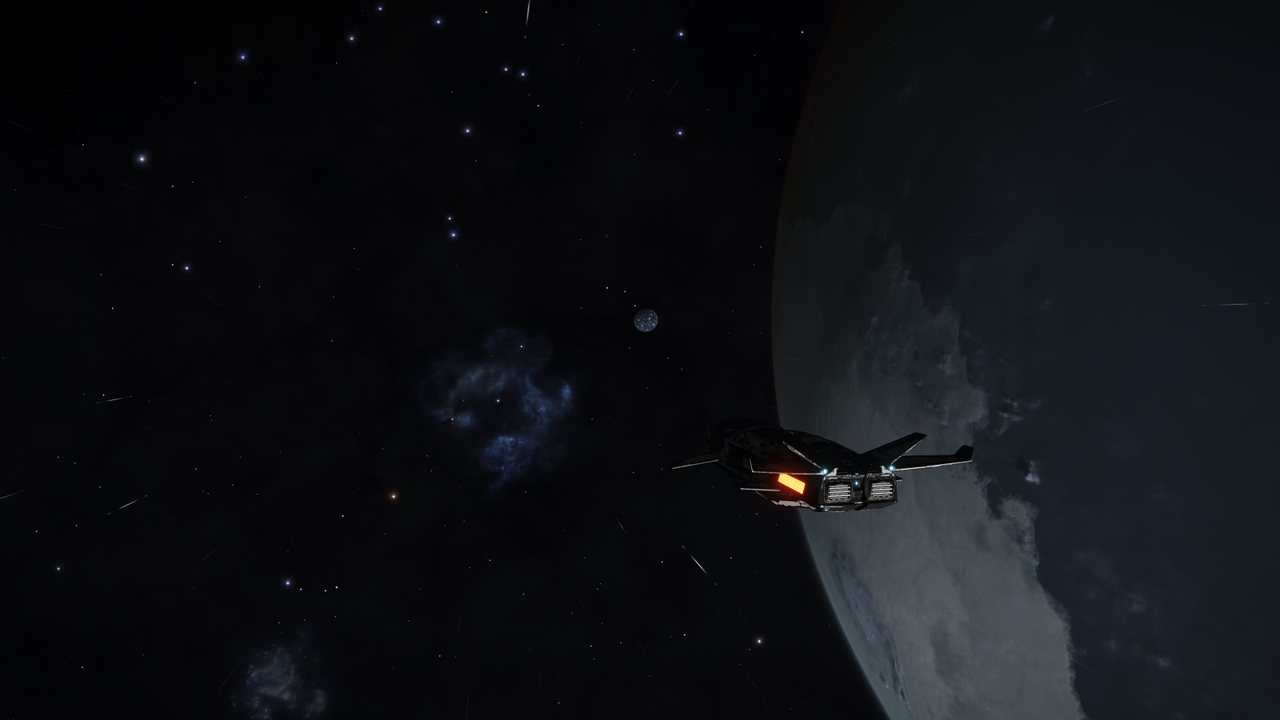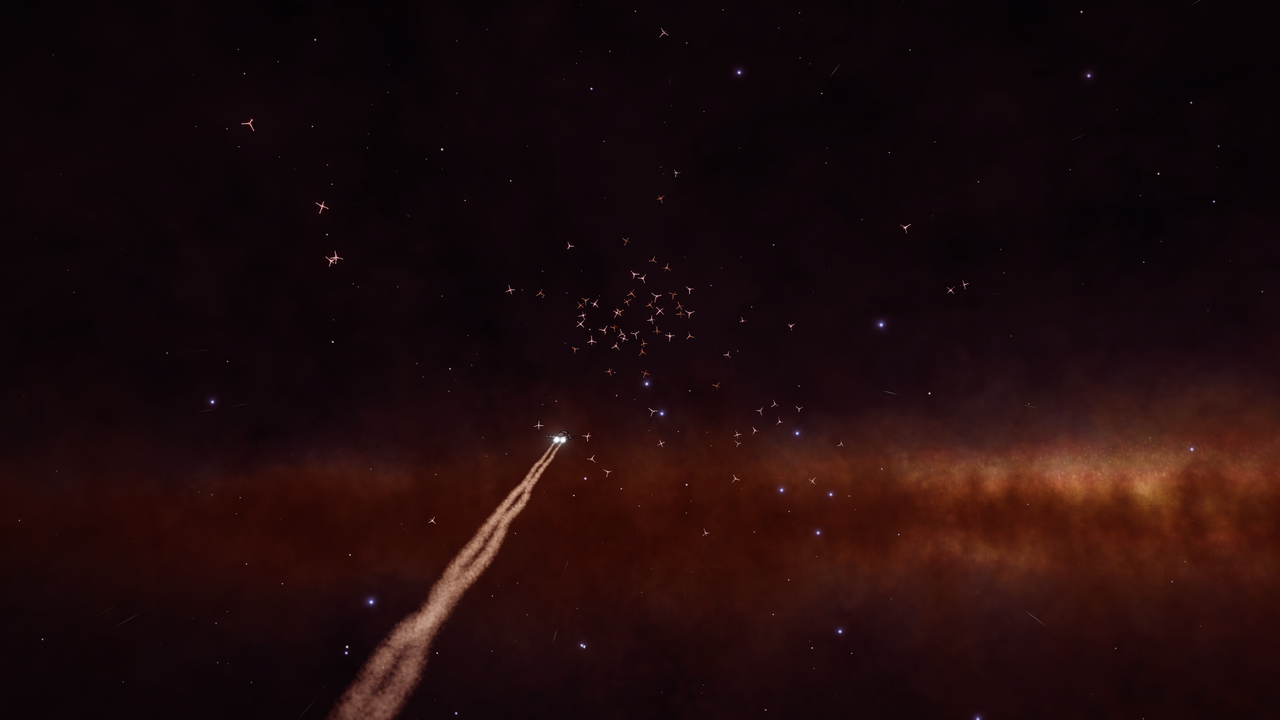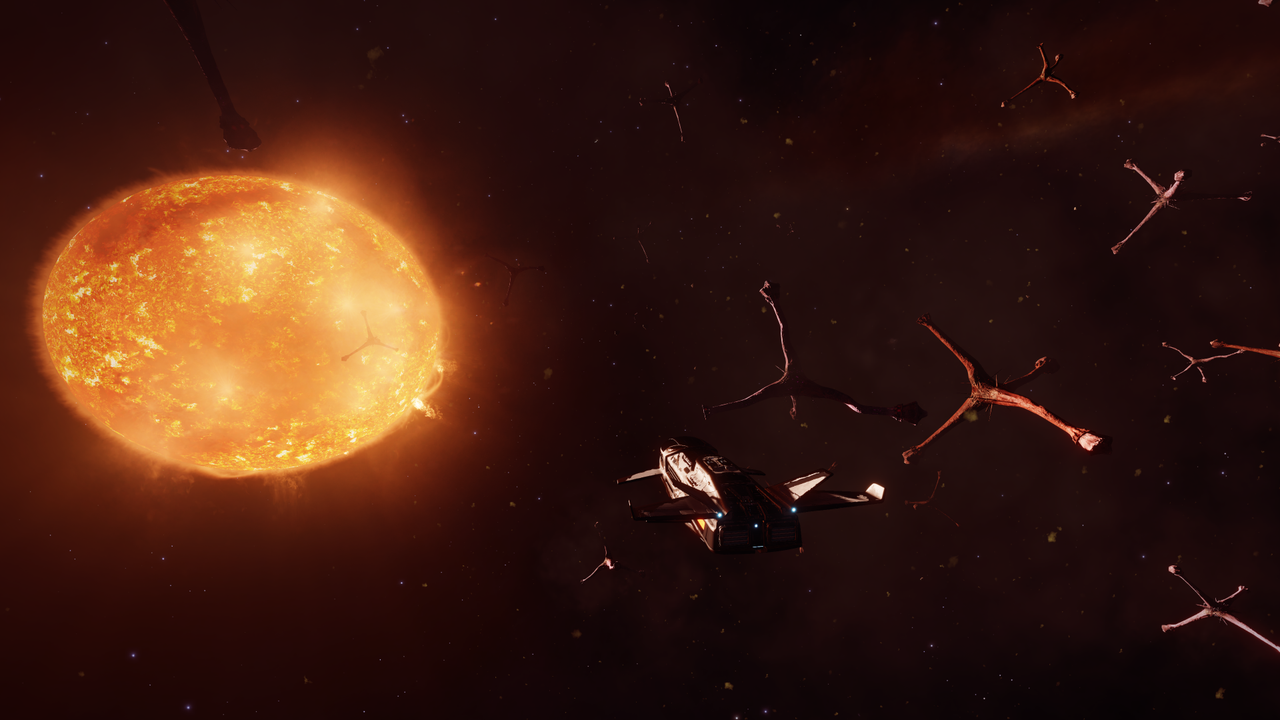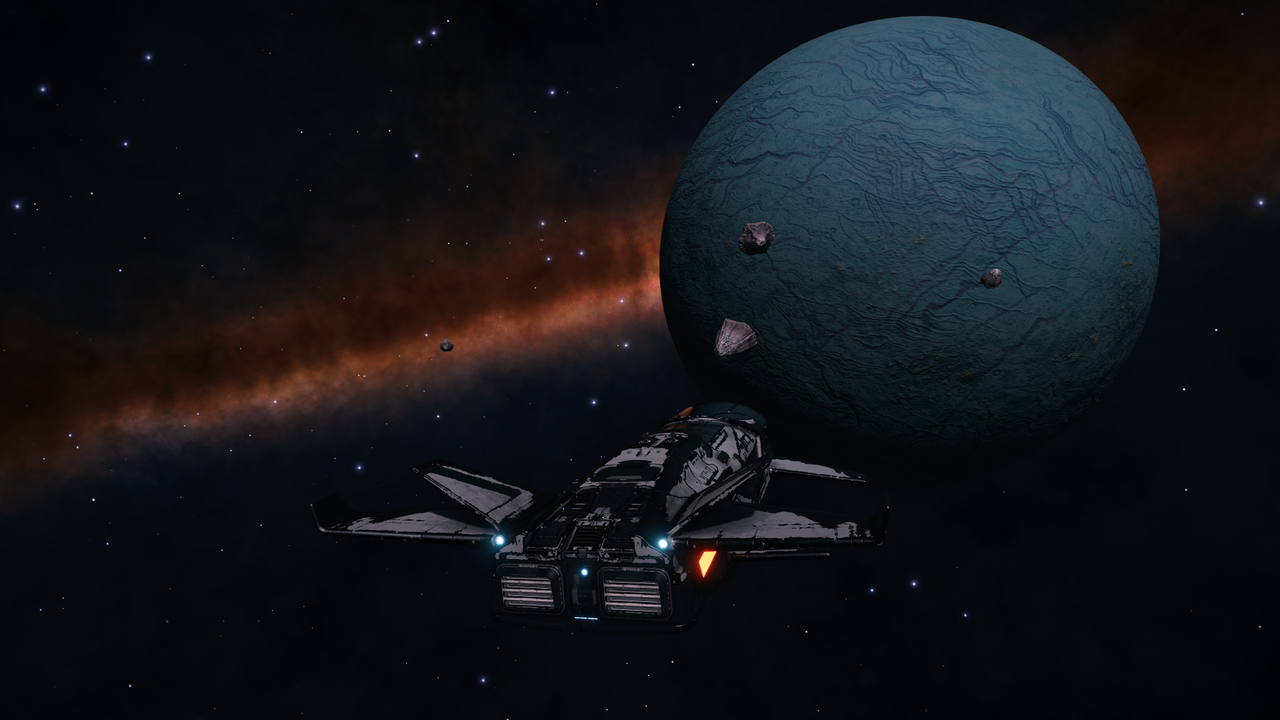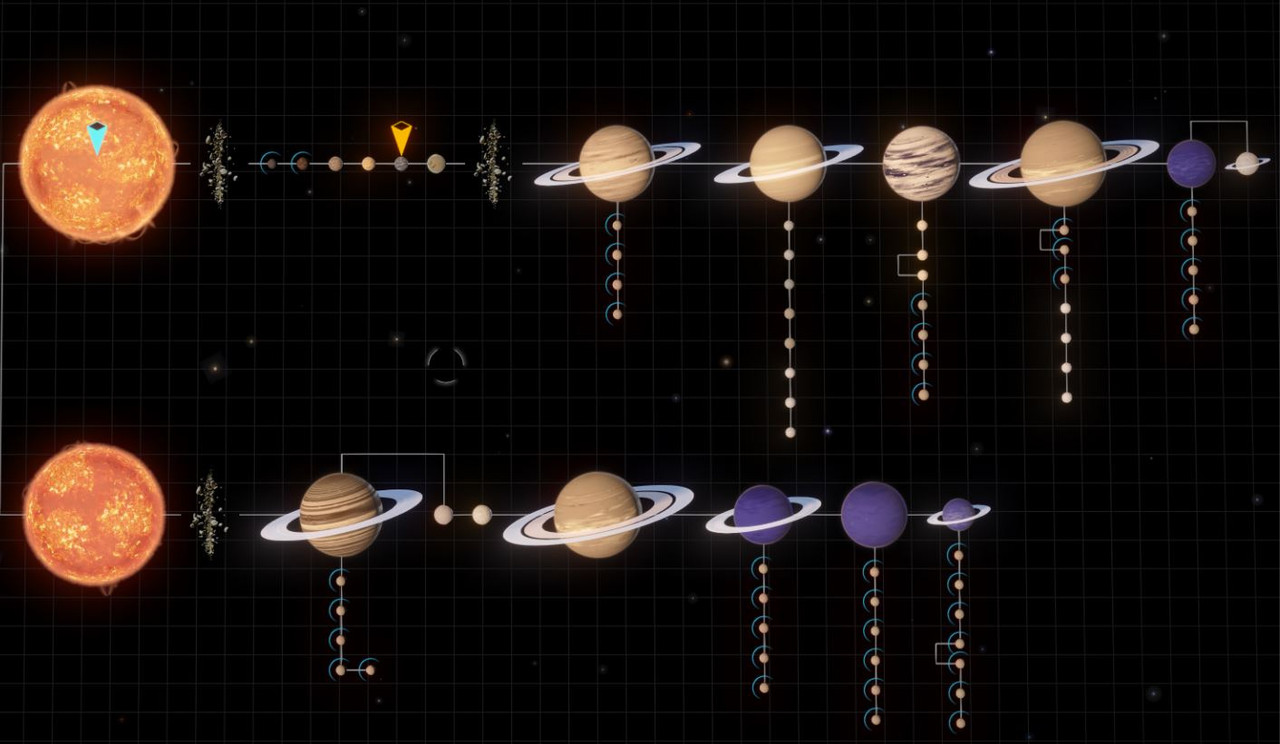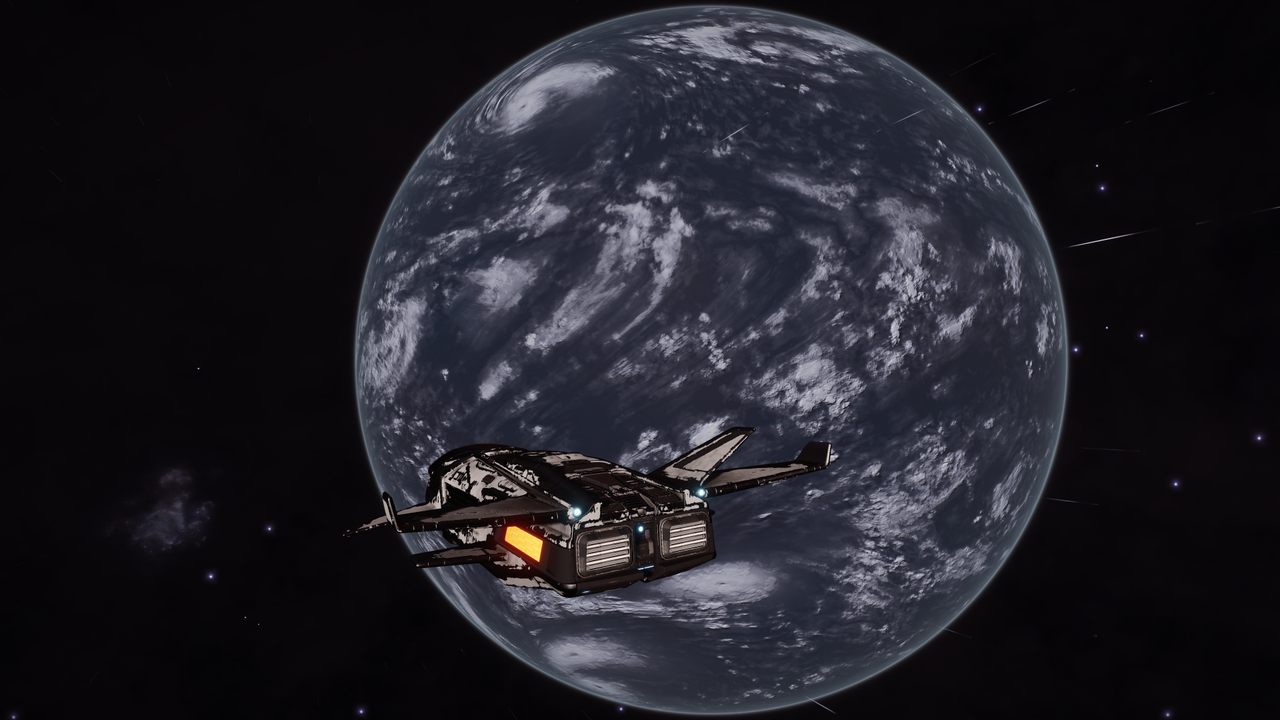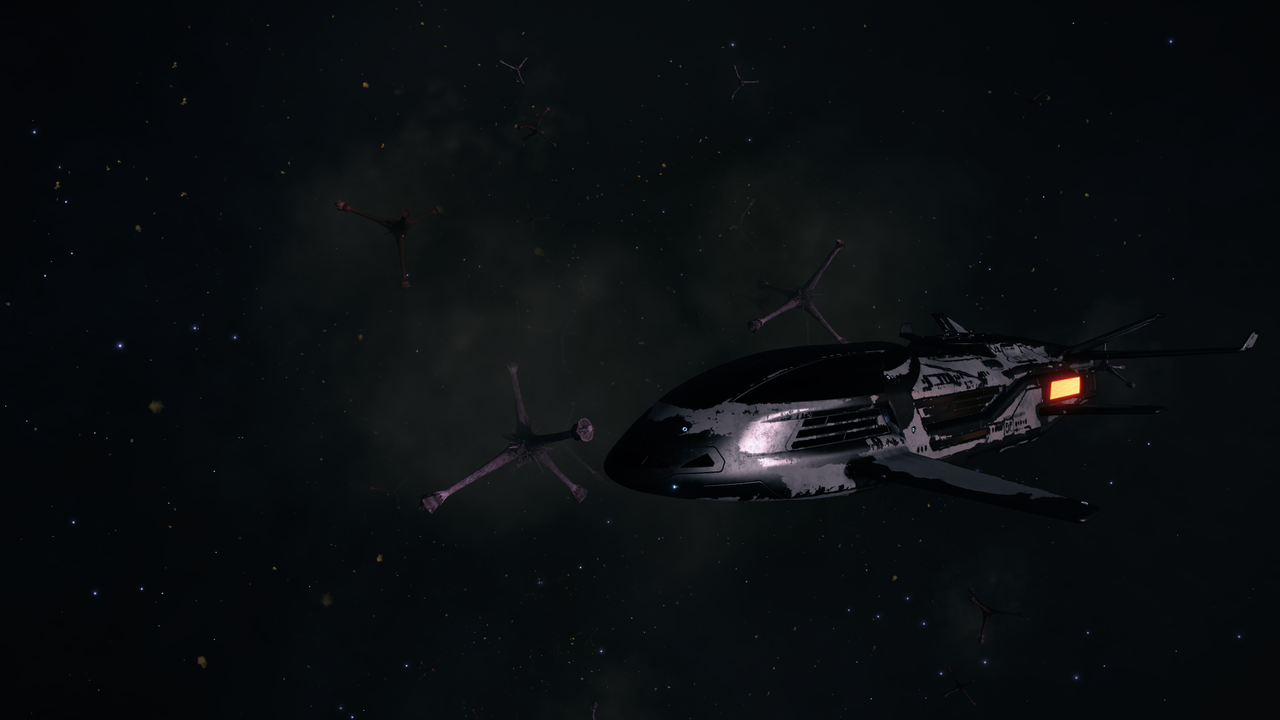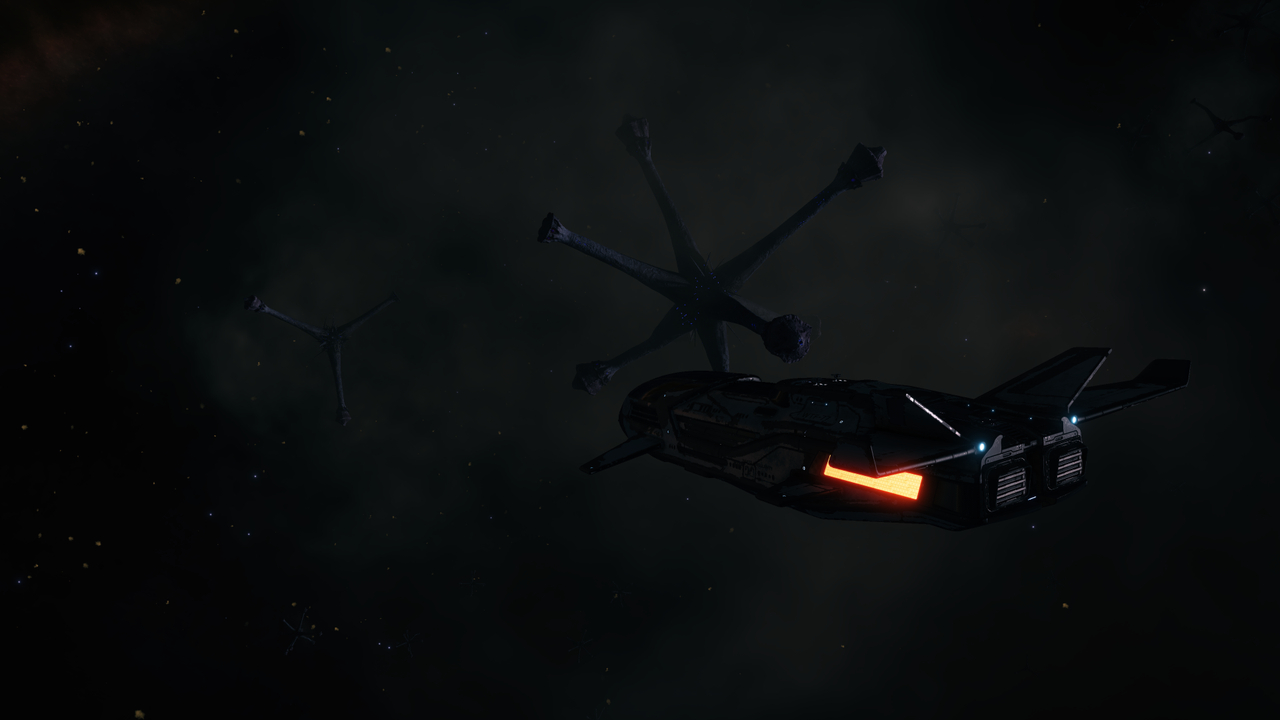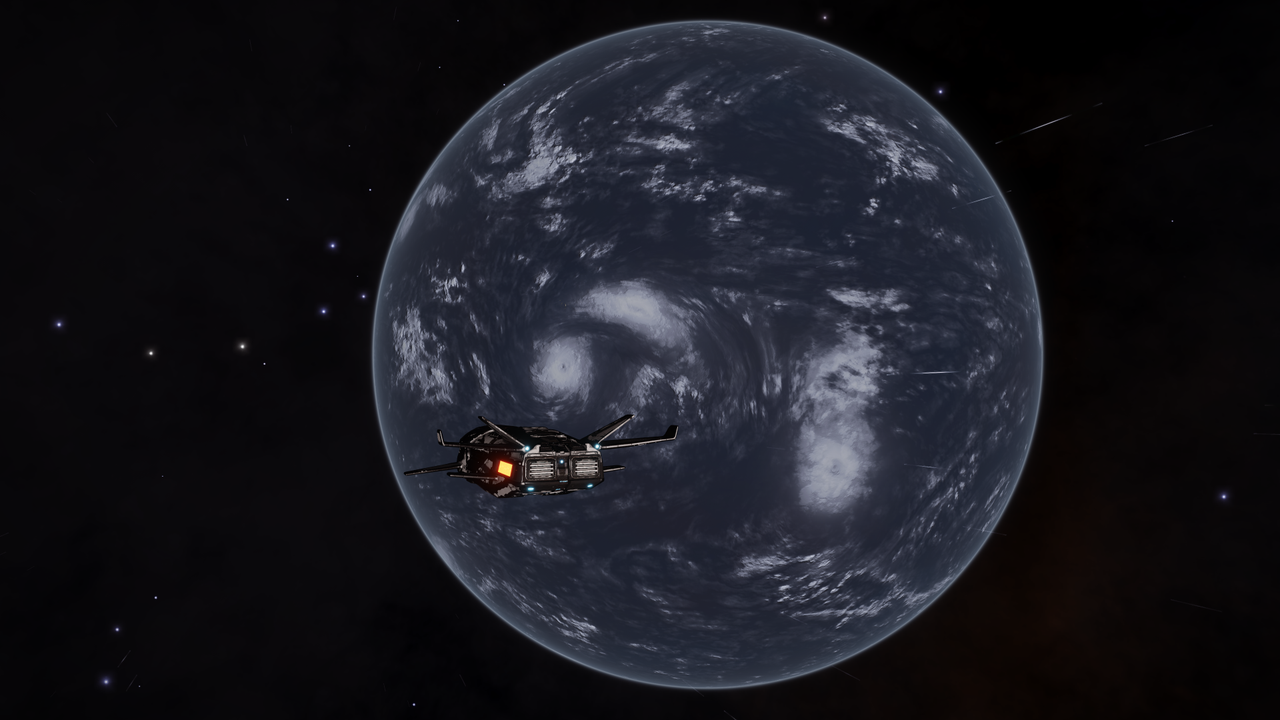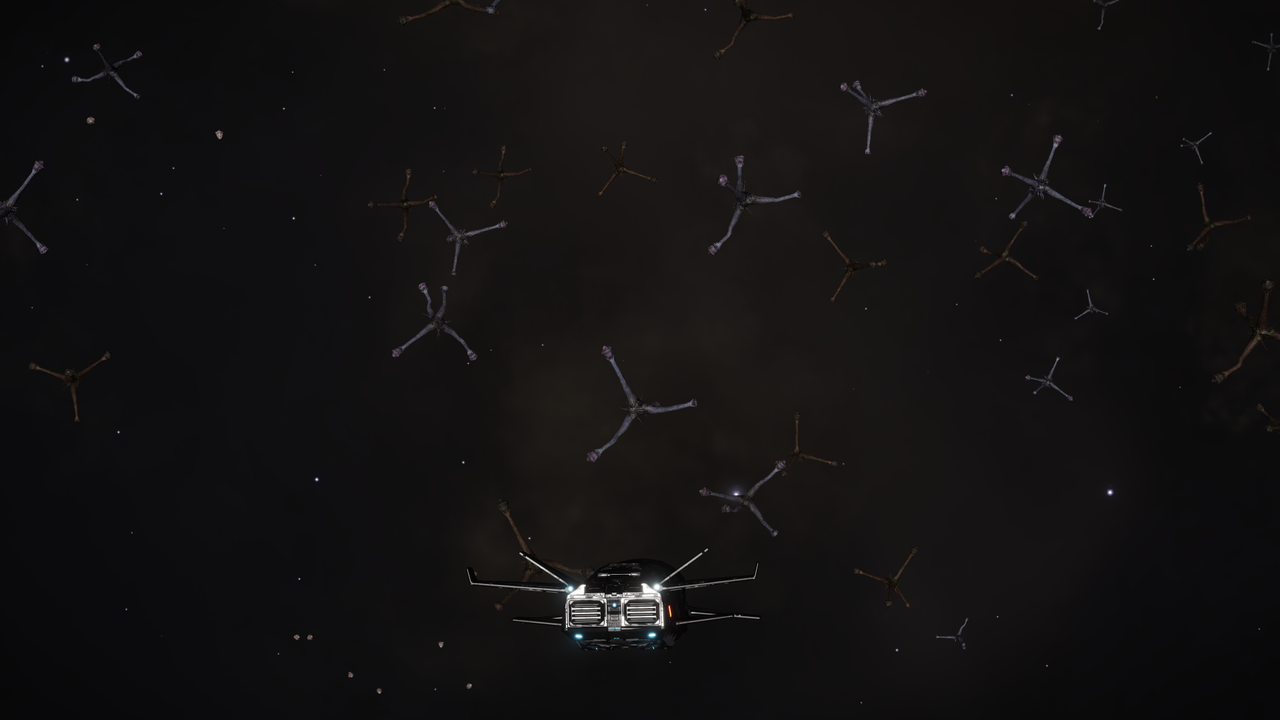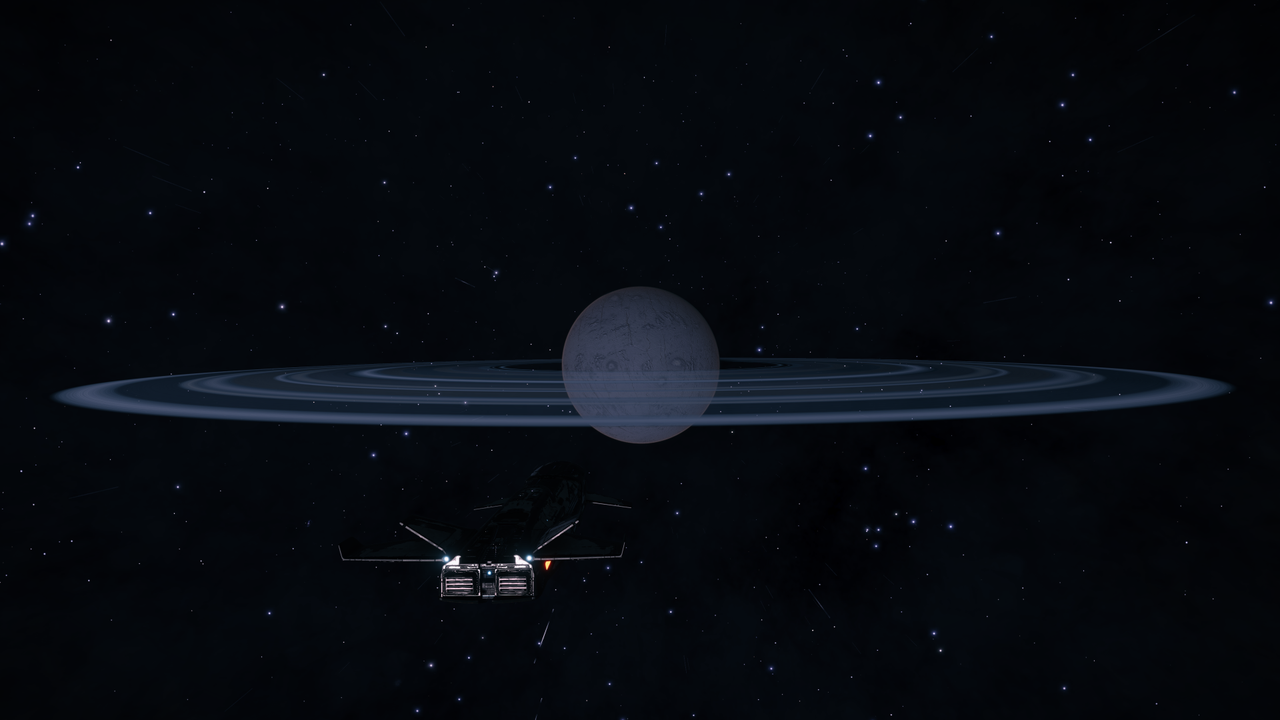We made a scenic stop for lunch and review the data we'd collected. One of the most prominent bits of data I turned up is that prolong exposure to deep space, even with a young woman as company, makes one easily amused, and I have definitely been amused by these pods. I spent the better part of an hour chasing a couple of them around, watching them jet away.
This Ammonia World is interesting for either its incredibly thick, dense atmosphere, or it's complete lack of any terrain features.
This is a region I've come to call the "soupy zone", thick with interstellar gasses and dust, like one massive nebula spanning hundreds, possibly thousands of light years.
Fumaroles are always interesting, be they ammonia or water ice.
A few jumps later, we found another system, this one remarkable for not one or two, but three proto-lagrange clouds, featuring more of these trees and their pods, as well as accompanying crystal formations. One of these features two distinct species of tree.
While these trees may be different, they all seem to spawn the same pods, and I have not been able to differentiate these pods from one another. Perhaps with better equipment I could match pods and trees by their genetic makeup. Unfortunately I do not have the sort of equipment to conduct this sort of analysis.
Fumaroles of nitrogen ice, aglow in the dim light of a distant star. I believe all the kinks have been worked out of the ship's system, though our makeshift repairs will certainly either impress or horrify maintenance teams for quite some time when we are able to dock up somewhere and put in for repairs.
This icy moon features some methane ice geysers at the bottom of a very deep chasm. The contrast between the icy walls of the chasm and the frozen soil at the base and the jets of the geysers, back lit by the star make for a very striking scene.
This water world shows vast undersea continents just below the surface of the water. Is this indicative of water loss, or the growth of land masses? Again, the limited equipment I carry makes it impossible to determine, but it is interesting nonetheless.
More trees and pods, in another system featuring three proto-lagrange clouds. I suspect the "soupy region" of Dryman's Point to be somewhat ideal for this particular form of life.
As it does seem to feature more than a few of these "forests" of Peduncle trees and their pods.
Lava spouts of searing silicon magma makes for a nice, soothing backdrop for a late dinner. It also prompted a question from Sai that I haven't considered in quite some time.
"If fire is a chemical reaction fueled by the oxidization of a fuel source, how is it that we have fire burning outside, on a moon with no atmosphere?"
I recalled asking a similar question quite some time ago, when there was a fire in the tungsten mines of Achenar 3. Sai's question made me smile a little as I gave nearly the same answer I was given.
"It's far simpler than it seems. That lava spout allows molten silicon to escape from deep below ground. While it makes it way to the surface, it either absorbs or breaks down bound oxygen present in other minerals, and as it reaches the surface, the temperature differentials cause that oxygen to be released, allowing fire to burn in that weak oxygenated envelop created."
Sai pondered my explanation.
"There's often much more at work, but that is the most common explanation."
"So how is it you wound up a pilot? You seem to have such a wide berth of knowledge on many subjects, and a knack for research."
I laughed a little. "I was encouraged many times, by many people to follow quite a few of those paths, but truth be told... well, I can't really say. I do enjoy research, and study of all manner of subjects, and as a pilot I often have plenty of time for study, and opportunities for conducting research. But I needed to make credits, and, well, being a pilot was a pretty quick way to do it. Research may be interesting, useful, fascinating even, but it can take years for it to be profitable. Study doesn't really make credits - it usually winds up costing credits, so what better options were there?"
Sai nodded. "Not really all that different from me then."
"Not really, no. In fact, it's one of the main reasons most pilots become pilots - we need credits, and piloting earns credits."
Another system, full of proto-lagrange clouds, and more proto-lagrange clouds filled with trees and pods.
This has to be the densest "forest" of trees I've seen yet.
Life on Earth is believed to have originated in the Earth's oceans. How life began in the oceans though, now there's an interesting question. Cyanobacteria, blue-green prokaryote algae, is said to be the earliest known form of life, and is not only still present, but one of the major components used in terraforming other planets. And how did the cyanobacteria begin? Random proteins and other proto-organic materials present in the precambrian seas, a bit of random convergence, perhaps a random stroke of lighting in just the right place at just the right time - all valid theories, but even to this day, these are the best theories we have.
There is, of course, another school of thought on the matter, one that my findings here lend credence to - that life on Earth began elsewhere, deep in space. I wonder what the outcome might be, if one of these pods were to land on a planet, like one of these many water worlds. Would it grow into something that would eventually become the ancestor of life on that world? Would it break down over time, dissolved into the waters of that world, and its trace elements become the seeds of life for that world? Certainly within the realm of possible. Or perhaps one of these pods might find itself embedded in the ice of a comet, carried far across space, and that comet might impact some distant world, seeding that world with both water and organic materials that would, in time, become the catalysts of life.
All still speculation and theory-craft, but certainly plausible.

The final jump on this leg of our trip lands us at an impressively large gas giant, teeming with ammonia-based life. Weighing in at 381.7064 Earth masses, with a radius of 68,481 km, and an atmospheric makeup of 75.2% hydrogen, 24.8% helium, this is one of the largest gas giants we've seen in quite some time. I also can't help but wonder if, if there is credence to the "seed theory", if this might not account for other forms of life as well, including the Thargoids. Could we ultimately have some common ancestor from the stars? Might all life throughout the galaxy, even throughout the universe itself, have some ancient-beyond-time ancestor? Ultimately, DNA is DNA, deoxyribonucleic acid, itself made up of adenine, thymine, guanine, and cytosine. Adenine is, chemically, C5H5N5. Thymine is, chemically, C5H6N2O2. Guanine is, chemically, C5H5N5O. Cytosine is, chemically, C4H5N3O. Carbon, Hydrogen, Nitrogen and Oxygen, the five ingredients that make up life. It is possible that life could be made of some other elements. Silicon is not outside the realm of possible as a base, instead of Carbon, but we know of no silicon-based life forms to this point. It is rather incredible though that so much variety can be made from so few ingredients.
The increased stellar density and Sai's tinkering with the routing computer have allowed me to plot the longest single course yet, 582 jumps, clear across Dryman's Point, and nearly completely across Sagittarius-Carina Arm, 19,962.63 light years, to what may actually be the one-quarter mark of our journey. Looking beyond, I suspect our time in some sectors ahead may be rather short, as stellar density begins to drop sharply once more. It will become imperative to plot accordingly in these regions to avoid any more back-tracking.
